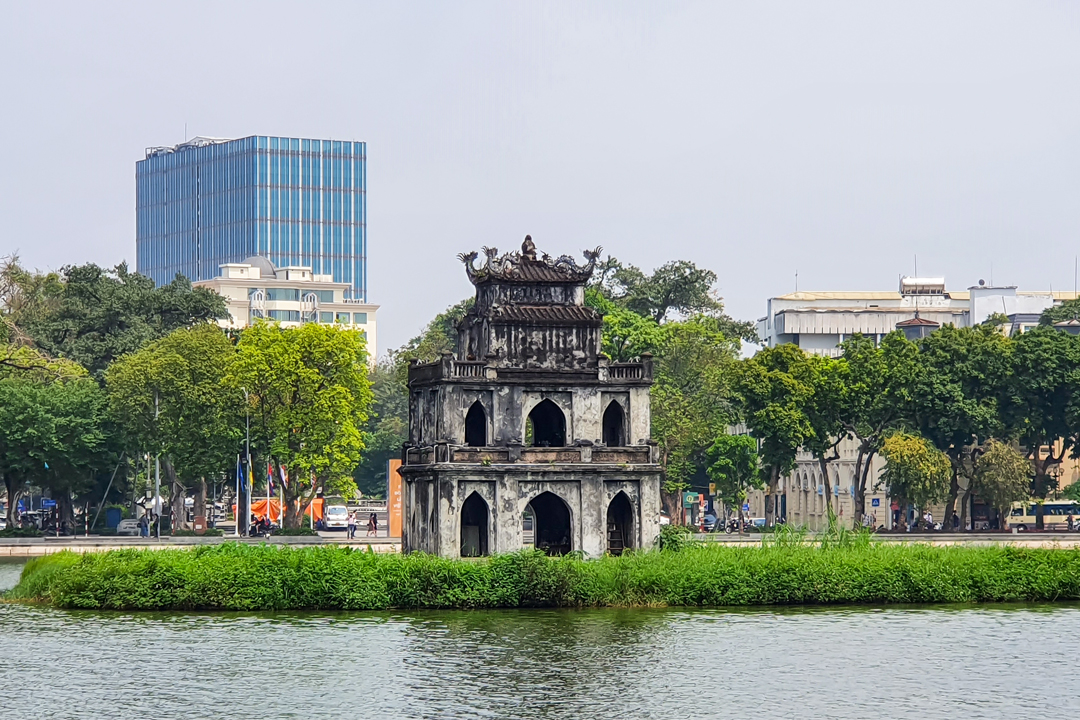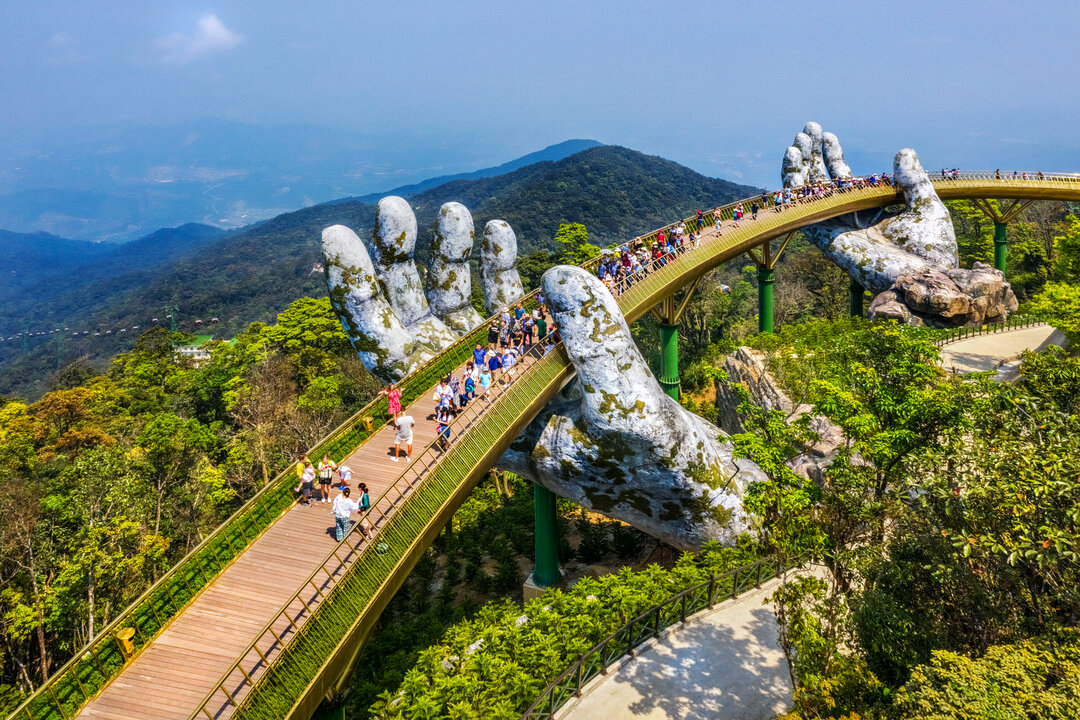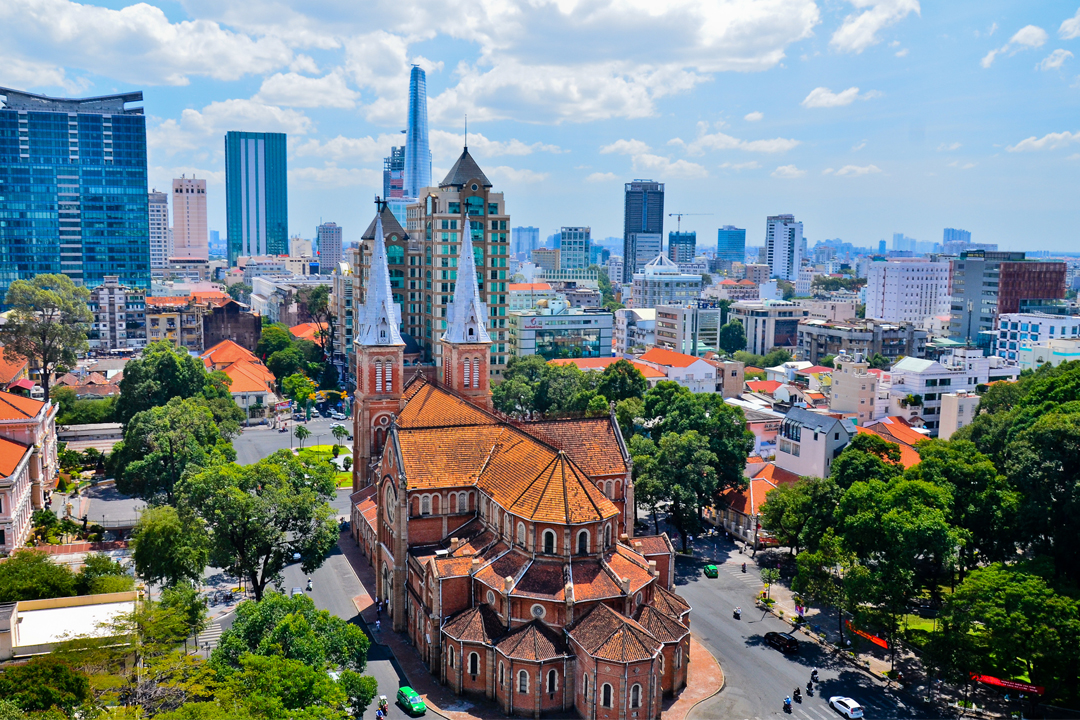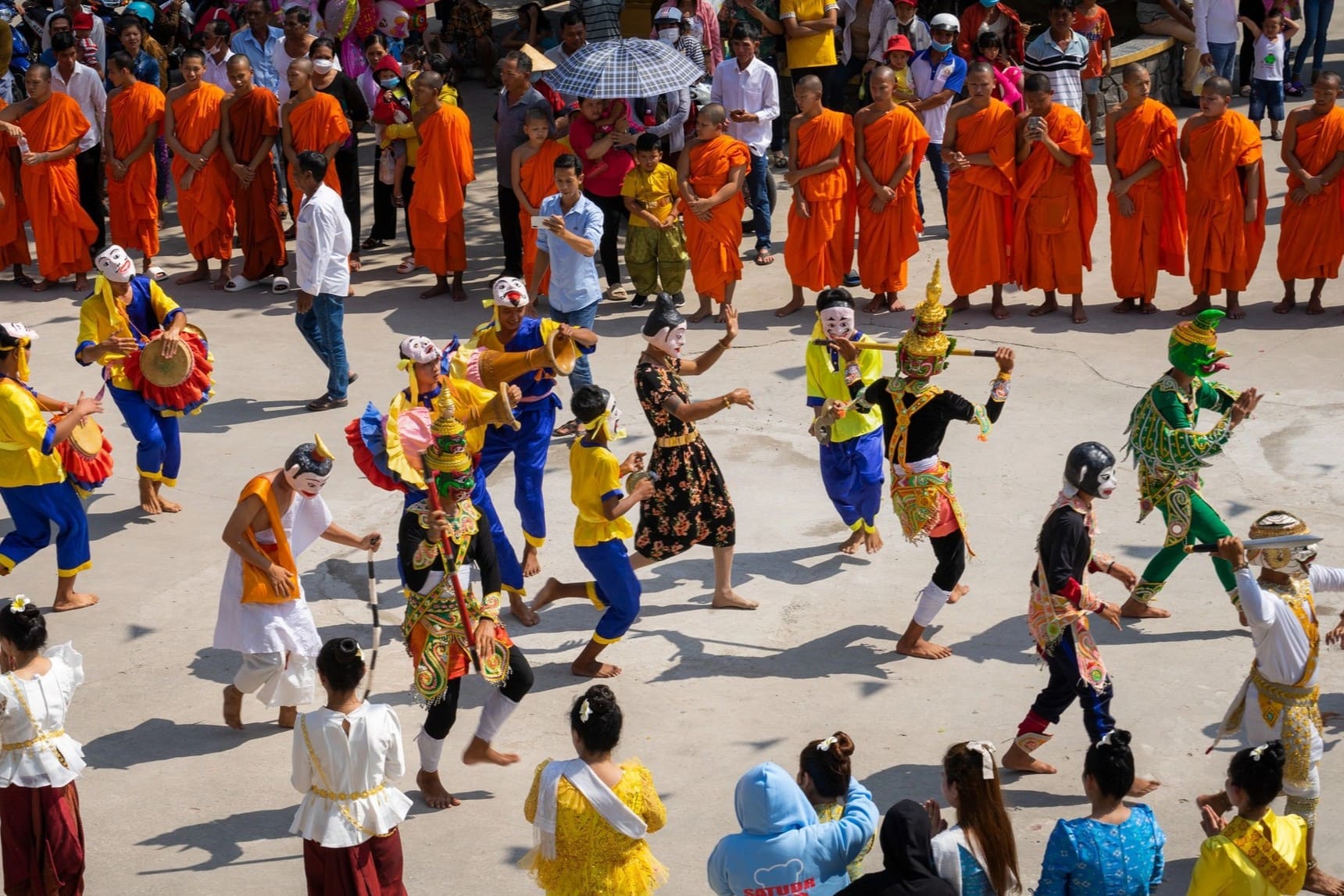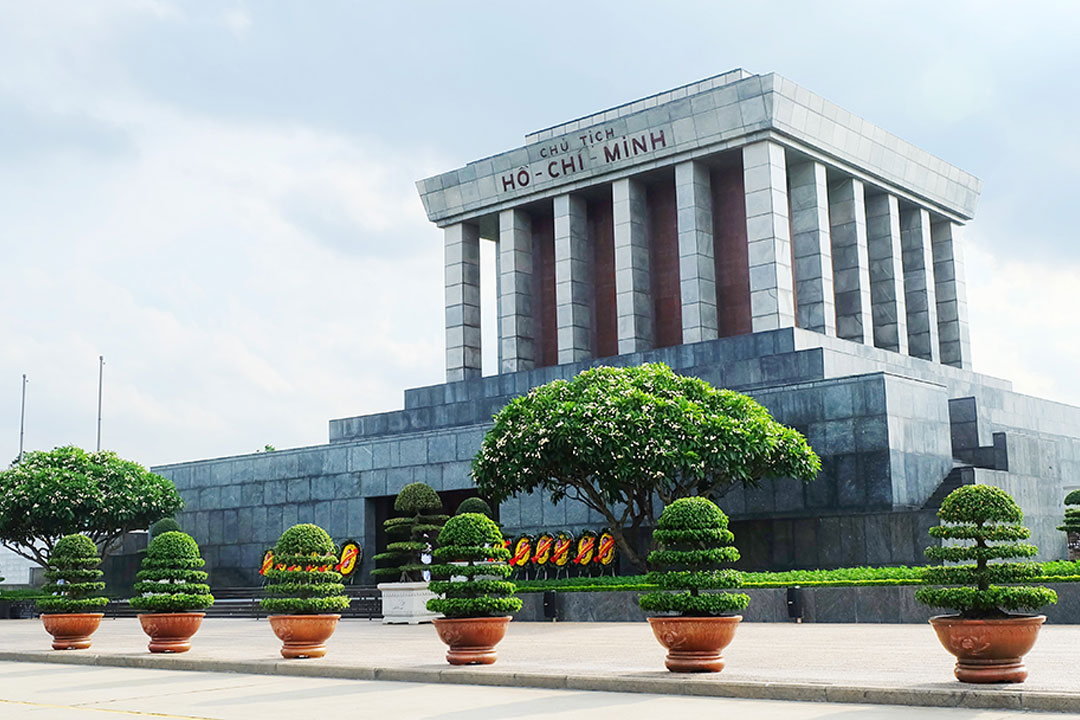Complex of President Ho Chi Minh: Overview, History, What To See & Travel Guide
The Complex of President Ho Chi Minh is more than just a historical site, it is a living narrative of Vietnam’s revolutionary past, deeply intertwined with the nation’s identity. Located in the heart of Hanoi, this vast memorial spans several landmarks, from the solemn Ho Chi Minh Mausoleum to the modest Stilt House. Each structure, including the Presidential Palace and Ba Dinh Square, tells a story of leadership, sacrifice, and national unity.
Beyond its architectural and political significance, the complex serves as an educational gateway, housing over 170,000 artifacts in the Ho Chi Minh Museum. They offer rare insights into Vietnam’s struggle for independence. If you’re a history enthusiast, a traveler seeking cultural depth, or someone drawn to the legacy of Ho Chi Minh, exploring this site unveils a profound chapter of Southeast Asian history.
But what makes this place so emotionally powerful? And how does each element contribute to the larger narrative of Vietnam’s resilience? Let’s delve into the intricate details behind this national treasure in this article of GTrip.
Overview of the Complex of President Ho Chi Minh
The Complex of President Ho Chi Minh is one of the most historically and culturally significant landmarks in Hanoi. It serves as a monumental tribute to Ho Chi Minh, the founding father of modern Vietnam. It is also an essential site for those seeking to understand the country’s struggle for independence and national unity.
You will explore key locations such as the Ho Chi Minh Mausoleum, Ho Chi Minh Museum, Stilt House, Presidential Palace, and Ba Dinh Square. The complex is both a sacred memorial and an educational hub that offers deep insights into Vietnamese history, politics, and culture.
Why it is a must-visit historical site in Hanoi?
The complex is more than just a collection of buildings, it represents the legacy of Ho Chi Minh, who played a pivotal role in Vietnam’s independence movement. His commitment to the people and his vision for a free, unified Vietnam are reflected in every aspect of the site. There are several reasons why this landmark is a must-visit:
- Historical and political significance: The complex is the final resting place of Ho Chi Minh and serves as a focal point for national pride, revolutionary history, and the ideological foundation of modern Vietnam.
- Diverse architectural styles: The various structures within the complex display a blend of architectural influences. They include Soviet neoclassical design (Mausoleum), French colonial architecture (Presidential Palace), and traditional Vietnamese aesthetics (Stilt House).
- Cultural and educational value: The Ho Chi Minh Museum houses over 170,000 artifacts and documents, providing in-depth insights into Vietnam’s past and its path to independence.
- Symbol of simplicity and leadership: Unlike the grandiose palaces of other world leaders, Ho Chi Minh’s Stilt House is a humble wooden structure that reflects his dedication to a simple life, aligned with the people’s hardships.
- Ba Dinh Square’s role in history: This was where Ho Chi Minh declared Vietnam’s independence on September 2, 1945, making it a site of immense historical significance.
With its combination of historical reverence, educational depth, and architectural diversity, the complex provides tourists with a multi-faceted experience that extends beyond mere sightseeing.

The complex is more than just a collection of buildings, it represents the legacy of Ho Chi Minh
Key components of the President Ho Chi Minh Complex
The Complex of President Ho Chi Minh comprises multiple landmarks, each playing a unique role in commemorating the life and achievements of Uncle Ho:
1. Ho Chi Minh Mausoleum
The Ho Chi Minh Mausoleum, built between 1973 and 1975, is a Soviet-inspired granite monument that serves as the final resting place of Ho Chi Minh. The preserved body of Vietnam’s revered leader is displayed inside, allowing people to pay their respects. A visit to the mausoleum requires adherence to strict dress codes and decorum guidelines. The atmosphere inside is solemn, with guards ensuring silence and order as people pass through. Standing 21.6 meters high and 41.2 meters wide, the mausoleum’s imposing structure symbolizes strength and endurance. Its design reflects both Vietnamese and Soviet architectural influences, making it a significant historical and cultural landmark in Hanoi.
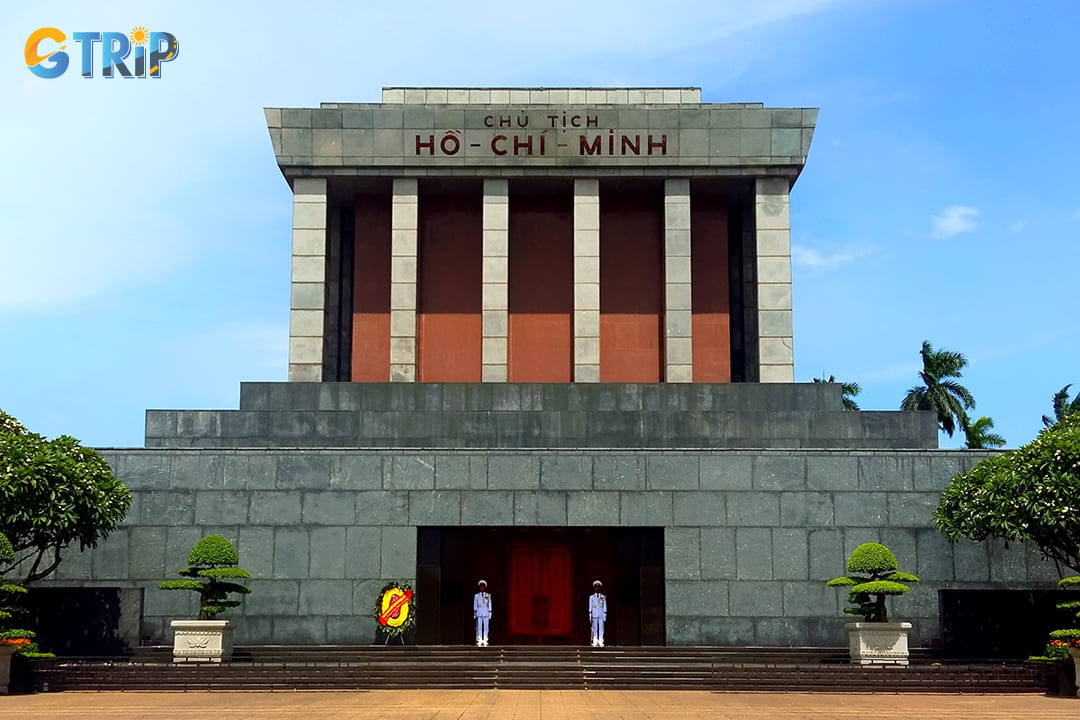
The Ho Chi Minh Mausoleum is a Soviet-inspired granite monument that serves as the final resting place of Ho Chi Minh
2. Ho Chi Minh Museum
The Ho Chi Minh Museum, inaugurated in 1990, is a vast repository of historical records, housing over 170,000 documents, artifacts, and films. These materials chronicle Ho Chi Minh’s life, his role in Vietnam’s independence, and the country’s revolutionary struggles. The museum’s exhibits are thoughtfully designed to educate tourists on Ho Chi Minh’s vision and political ideology. Displays highlight his contributions to global anti-colonial movements, emphasizing his influence beyond Vietnam. Through interactive displays and well-curated collections, the museum offers deep insights into Vietnam’s history and the enduring legacy of its most iconic leader.
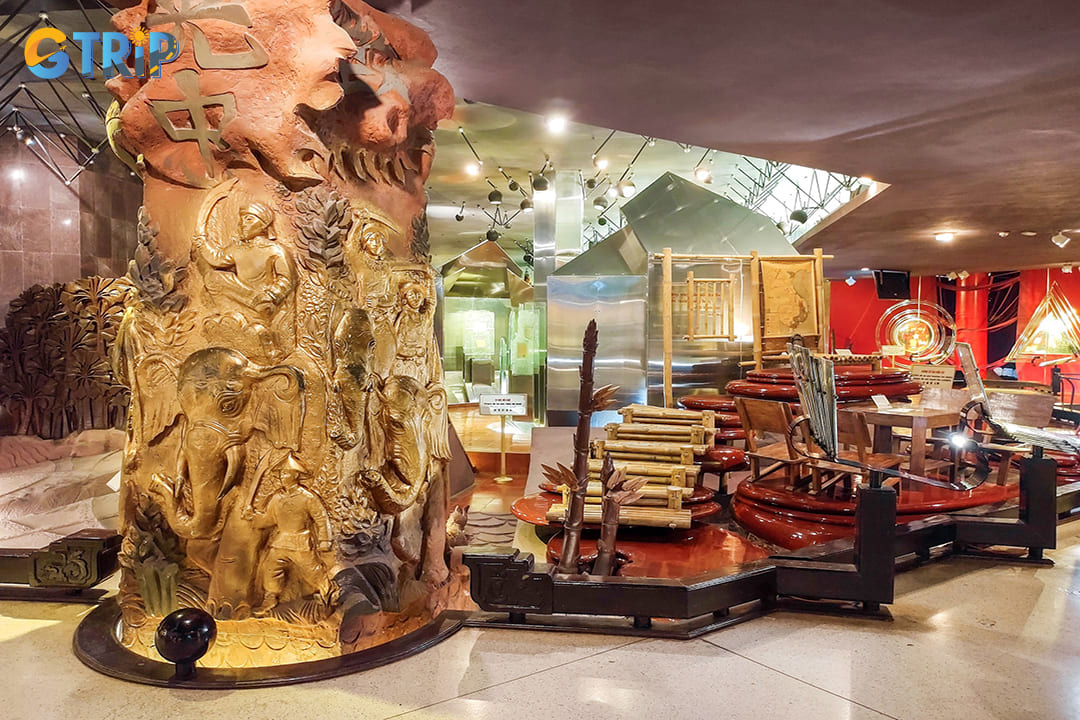
The Ho Chi Minh Museum is a vast repository of historical records, housing over 170,000 documents, artifacts, and films
3. Ho Chi Minh’s Stilt House
Ho Chi Minh’s Stilt House, built in 1958, served as both his residence and workplace until his passing in 1969. This traditional Vietnamese wooden house reflects his simple way of living, in contrast to the grand structures nearby. Measuring approximately 10.5 meters by 6.2 meters, the house remains well-preserved, offering a glimpse into his daily life. Its design, elevated on stilts, follows the architectural style commonly found in rural Vietnam. Surrounded by lush gardens and a peaceful fish pond, the stilt house symbolizes Ho Chi Minh’s humility and deep connection with nature. Today, it stands as a cherished historical site, drawing those who wish to understand the leader’s personal life and philosophy.
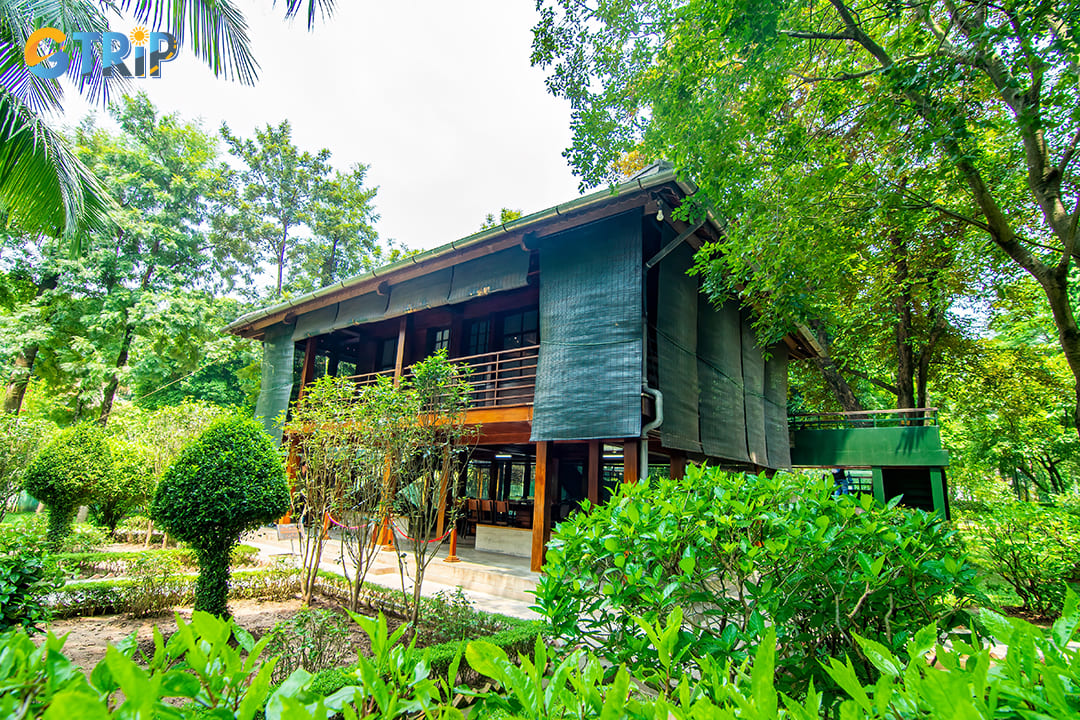
Ho Chi Minh’s Stilt House served as both Ho Chi Minh’s residence and workplace
4. Presidential Palace Historical Site
The Presidential Palace Historical Site, once the residence of the French Governor-General of Indochina, is a striking example of colonial architecture. Its grand yellow facade and European design stand in stark contrast to Ho Chi Minh’s preference for a modest lifestyle. Although the palace itself is not open to the public, you can explore the beautifully maintained gardens and nearby historical buildings. House No. 54, a simple structure where Ho Chi Minh first lived in Hanoi, and House No. 67, a war-time meeting place, offer deeper insights into his daily life and leadership. This site serves as a reminder of Vietnam’s colonial past while honoring Ho Chi Minh’s enduring legacy of humility and dedication to his people.
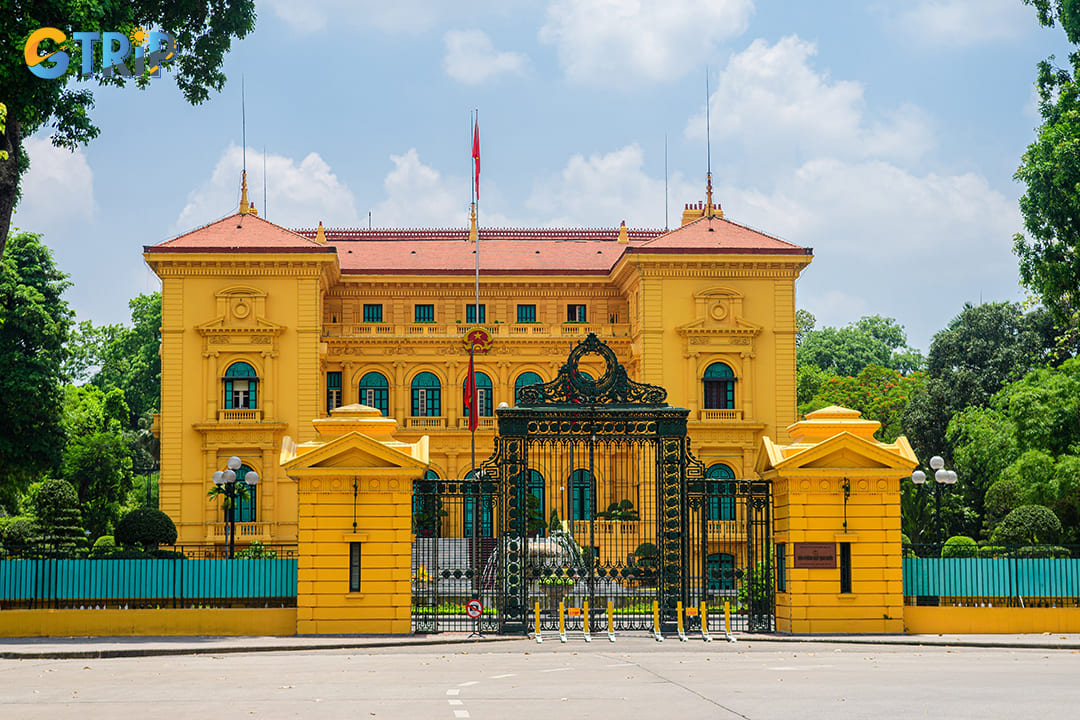
The Presidential Palace Historical Site is a striking example of colonial architecture
5. Ba Dinh Square
Ba Dinh Square is the largest public square in Vietnam, covering an area of 320 meters by 100 meters. With a capacity of up to 20,000 people, it has been the site of numerous historic events. Most notably, on September 2, 1945, Ho Chi Minh stood here to read Vietnam’s Declaration of Independence, marking the birth of the Democratic Republic of Vietnam. Today, the square continues to host major national events, including Independence Day celebrations, military parades, and state ceremonies. Lined with lush green lawns and flanked by significant landmarks such as the Ho Chi Minh Mausoleum, Ba Dinh Square remains a symbol of national pride and unity.
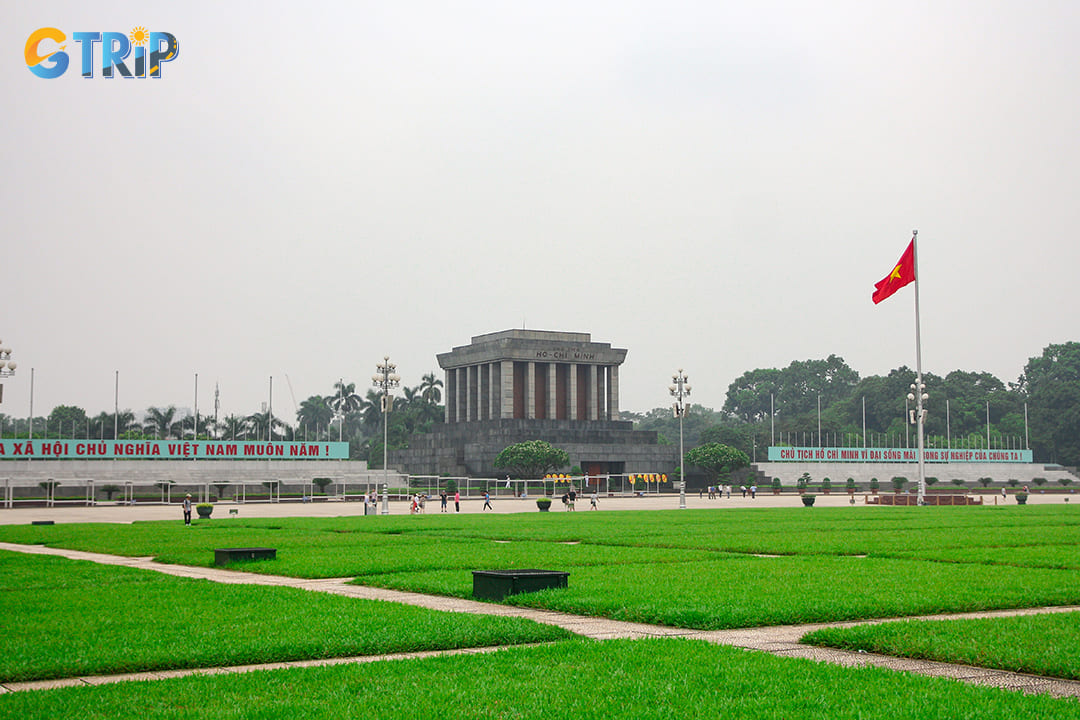
Ba Dinh Square is the largest public square in Vietnam
6. One Pillar Pagoda
The One Pillar Pagoda, originally constructed in 1049 during the Ly Dynasty, is one of Vietnam’s most revered Buddhist temples. Its unique design, resembling a lotus flower emerging from the water, symbolizes purity and enlightenment in Buddhist philosophy. Although not directly connected to Ho Chi Minh, the pagoda’s location within the Ho Chi Minh Complex highlights Vietnam’s deep-rooted cultural and religious traditions. It serves as a reminder of the nation’s rich spiritual heritage, coexisting with the country’s political history. Today, the One Pillar Pagoda remains a significant site for both pilgrims and tourists. It stands as a testament to Vietnam’s harmonious blend of history, politics, and spirituality, making it an essential stop for those exploring the legacy of Ho Chi Minh and the broader cultural landscape of Hanoi.
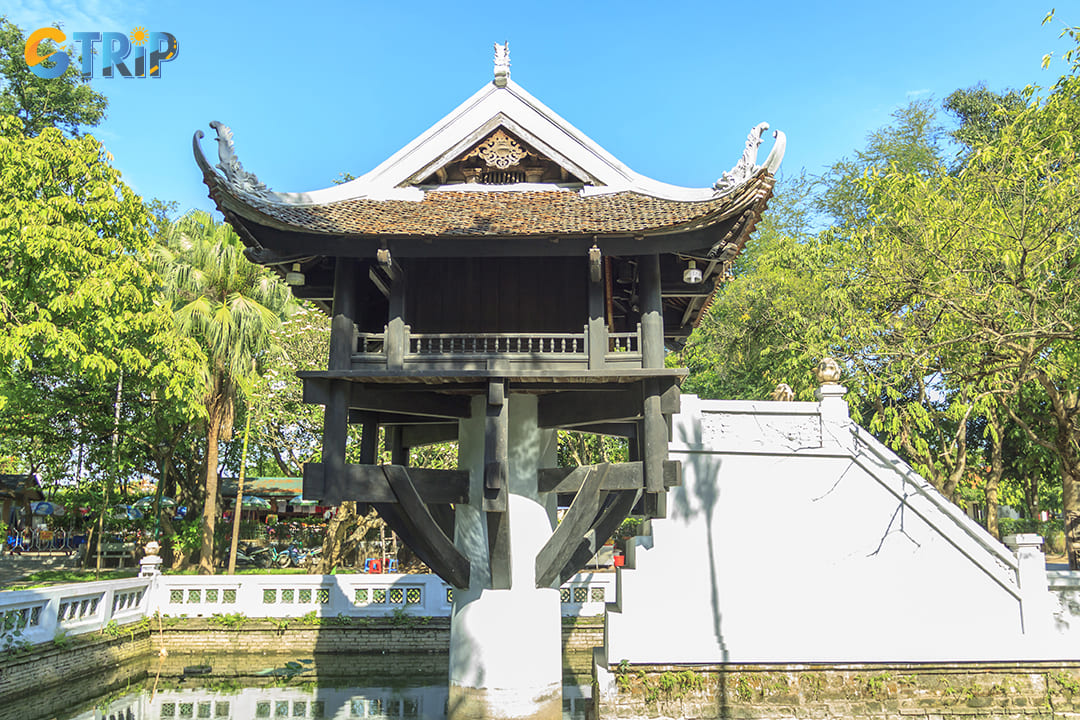
The One Pillar Pagoda is one of Vietnam’s most revered Buddhist temples
In summary, the Complex of President Ho Chi Minh stands as an enduring testament to Vietnam’s struggle for independence and the leadership of Uncle Ho. It is not just a tourist attraction, but a place of national reverence, ensuring that the memory of Ho Chi Minh and his contributions remain alive for generations to come.
Historical background of the Complex of President Ho Chi Minh
The Complex of President Ho Chi Minh is a historically and politically significant site in Vietnam, preserving the legacy of Ho Chi Minh and the country’s struggle for independence. Located in Hanoi, the complex was established to honor the revolutionary leader’s contributions and to serve as an educational space reflecting Vietnam’s political history. The decision to build the complex in Hanoi was driven by its central role in Vietnam’s independence movement, as it was from here that Ho Chi Minh led the country through key historical events.
Ho Chi Minh, born Nguyen Sinh Cung (1890-1969), was the architect of modern Vietnam. As the leader of the Vietnamese communist movement, he played a pivotal role in the country’s liberation from French colonial rule and its resistance against American intervention during the Vietnam War. His leadership in the August revolution of 1945 led to the Proclamation of Independence at Ba Dinh Square, now a core part of the complex. Despite his position, Ho Chi Minh lived simply, rejecting the opulent French-colonial Presidential Palace in favor of a modest stilt house. This house is preserved within the complex as a symbol of his humility and commitment to the people.
The choice of Hanoi as the site for the complex holds deep historical and political significance. As the capital of North Vietnam and the center of revolutionary activities, Hanoi was the stronghold of Ho Chi Minh’s leadership. It was also where he proclaimed Vietnam’s independence in 1945, making it the most fitting location to commemorate his legacy. Additionally, the complex integrates a mix of architectural influences, including Soviet neoclassical, traditional Vietnamese, and French colonial styles, reflecting Vietnam’s historical transitions.
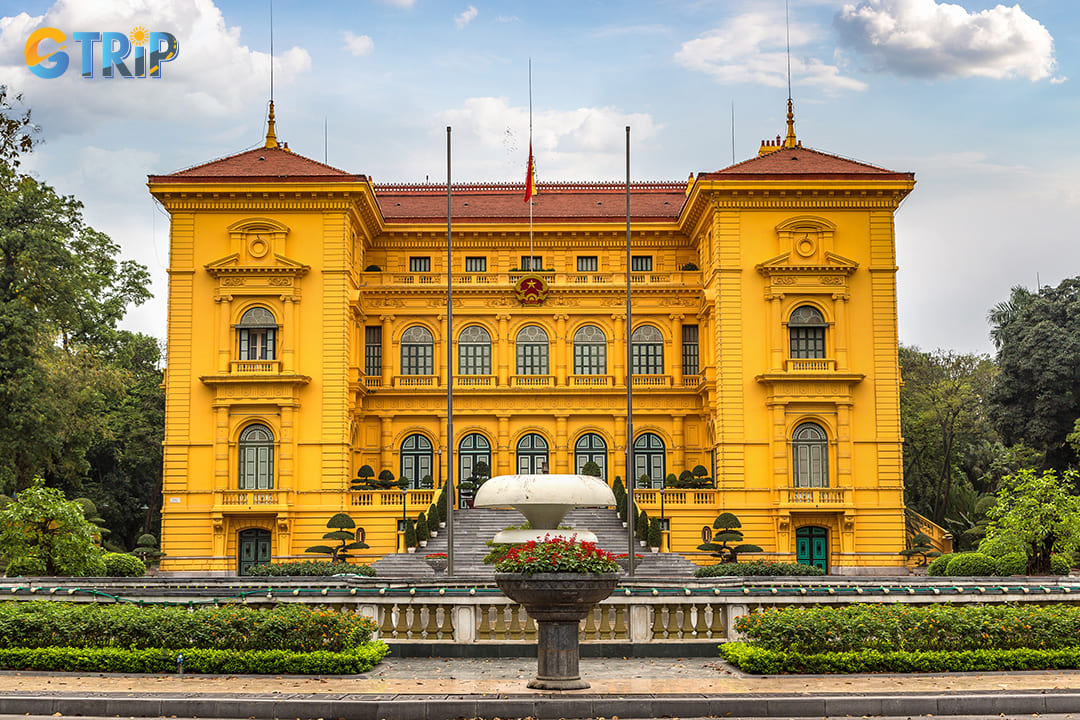
The Complex of President Ho Chi Minh is a historically and politically significant site in Vietnam
Each landmark within the complex holds distinct historical and political meanings. The Ho Chi Minh Mausoleum, inspired by Lenin’s Mausoleum in Moscow, was built between 1973 and 1975 despite Ho Chi Minh’s wish to be cremated. It serves as a site of national unity, where millions visit annually to pay their respects. The Ho Chi Minh Museum, inaugurated in 1990, showcases over 170,000 artifacts detailing his life and ideology, reinforcing Marxist-Leninist principles and Vietnam’s revolutionary journey. His stilt house, built in 1958, remains a powerful symbol of his dedication to simplicity and equality. The Presidential Palace historical site, originally the French governor-general’s palace, marks the transition from colonial rule to national sovereignty, with House No. 67 serving as the place where Ho Chi Minh spent his final days.
Finally, Ba Dinh Square, where Ho Chi Minh declared independence, remains the political heart of Vietnam, hosting national celebrations and state ceremonies. Nearby, the One Pillar Pagoda, an ancient Buddhist structure within the complex, represents the nation’s enduring spiritual and cultural traditions. This aligns with Ho Chi Minh’s vision of preserving Vietnam’s heritage. Through its historical landmarks and ideological significance, the Complex of President Ho Chi Minh stands as a living testament to Vietnam’s revolutionary history and the enduring legacy of its greatest leader.
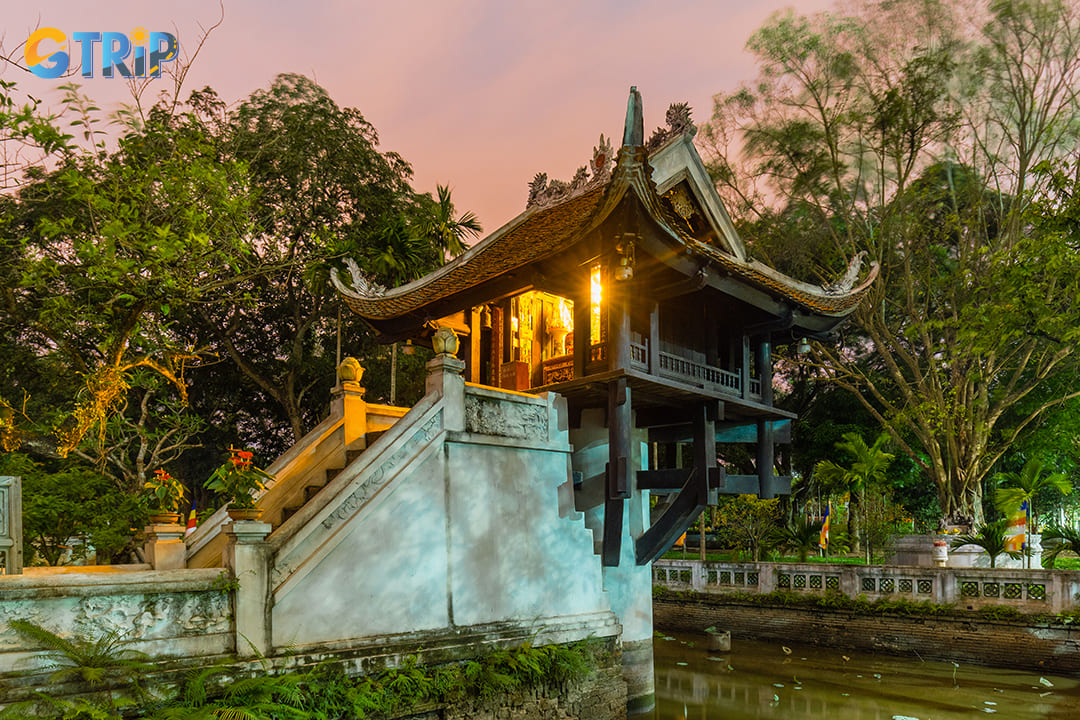
One Pillar Pagoda represents the nation’s enduring spiritual and cultural traditions
What to see when visiting the Complex of President Ho Chi Minh?
The Complex of President Ho Chi Minh is an interwoven ensemble of monuments, each echoing a distinct facet of Vietnam’s revolutionary history and cultural heritage. Each landmark within the complex plays a vital role in narrating the story of Ho Chi Minh’s leadership and the nation’s journey toward independence. In the sections below, we examine these key landmarks in detail, along with their practical visitor information, including precise opening hours presented in easy-to-read tables.
1. Ho Chi Minh Mausoleum
Located at 1 Hung Vuong, Dien Bien, Ba Dinh, Hanoi, the Ho Chi Minh Mausoleum is the heart of the historic Ho Chi Minh Complex. Constructed between 1973 and 1975, the structure was heavily influenced by Soviet neoclassical design, inspired by Lenin’s Mausoleum in Moscow. Inside, Ho Chi Minh’s embalmed body rests in a glass sarcophagus, drawing millions of tourists who come to pay their respects each year.
The mausoleum is more than just a resting place, it stands as a powerful symbol of Vietnam’s struggle for independence. Built during the Cold War, it also reflects the strong ideological connection between North Vietnam and the Soviet bloc. The structure embodies the resilience and unity of the Vietnamese people, honoring Ho Chi Minh’s lifelong dedication to the nation.
Constructed from grey granite, the mausoleum has a solemn and imposing presence. The structure measures 21.6 meters in height and 41.2 meters in width, exuding strength and endurance. Surrounding the building are carefully manicured gardens, enhancing the tranquil and dignified atmosphere of the site.
As a place of deep reverence, the mausoleum enforces strict rules. Tourists must follow a dress code, covering shoulders and knees, to show respect. Silence is required inside, and photography is strictly prohibited. Four honor guards stand watch over Ho Chi Minh’s body, maintaining the solemnity of the experience. These regulations ensure that the site remains a fitting tribute to one of Vietnam’s most revered leaders.
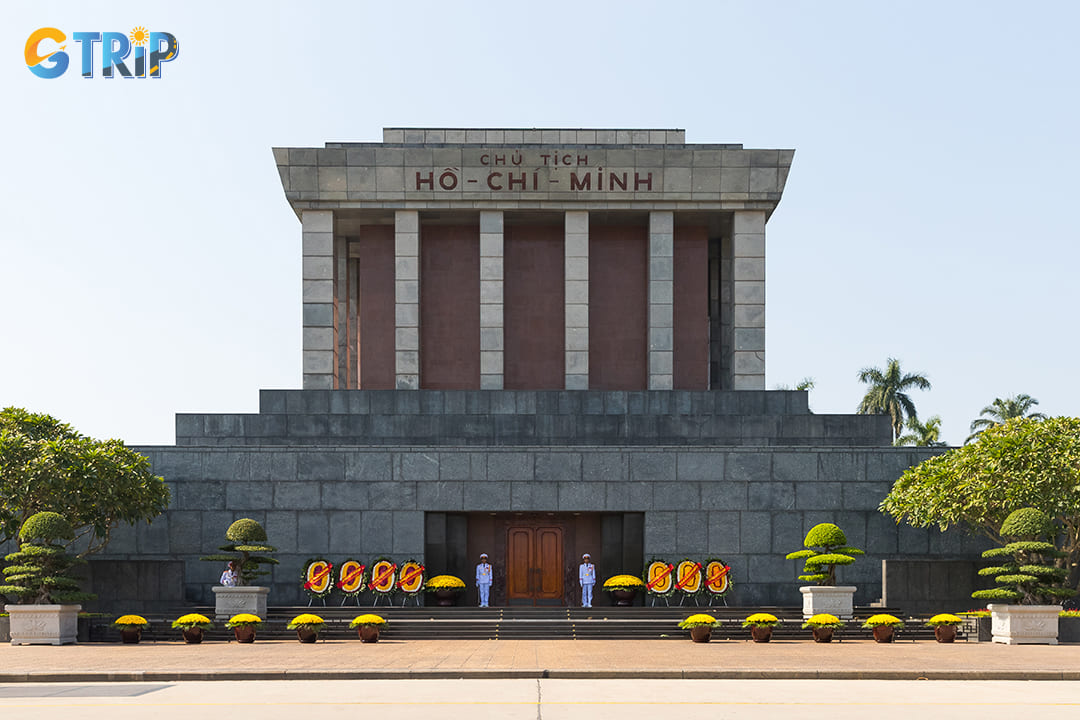
The mausoleum is more than just a resting place, it stands as a powerful symbol of Vietnam’s struggle for independence
Opening hours & entrance fee:
- Opening hours
| Season | Days | Opening hours |
|---|---|---|
| Hot season (April - October) | Tuesday, Wednesday, Thursday | 7:30 AM - 10:30 AM |
| Monday, Friday | Closed | |
| Saturday, Sunday, Holidays | 7:30 AM - 11:00 AM | |
| Cold season (November - March) | Tuesday, Wednesday, Thursday | 8:00 AM - 11:00 AM |
| Monday, Friday | Closed | |
| Saturday, Sunday, Holidays | 8:00 AM - 11:30 AM |
Note: Opening schedules on May 19, September 2, or the first day of the Lunar New Year (if coinciding with Monday or Friday) may differ.
- Entrance fee: Free for both Vietnamese citizens and foreign tourists.
2. Ho Chi Minh Museum
Located at 19 Ngoc Ha Street, Doi Can Ward, Ba Dinh District, Hanoi, the Ho Chi Minh Museum is a vast historical repository dedicated to the life and legacy of Vietnam’s revolutionary leader. Opened in 1990, the museum houses over 170,000 documents, artifacts, and films, offering a comprehensive look into Vietnam’s struggle for independence and Ho Chi Minh’s pivotal role in shaping the nation.
The museum is structured into thematic displays, each focusing on a different aspect of Ho Chi Minh’s life. You can explore exhibits covering his early years, revolutionary campaigns, and global influence. Artifacts, photographs, and personal belongings paint a vivid picture of his dedication to Vietnam’s independence and the broader anti-colonial movements worldwide.
Beyond being a historical archive, the museum serves as an important educational center. It offers multimedia presentations, interactive exhibits, and guided tours, making it an engaging space for students, researchers, and history enthusiasts. Through these resources, you gain deeper insights into Ho Chi Minh’s ideology, leadership, and impact on global revolutionary movements.
With a structured layout, the museum provides a chronological journey through Vietnam’s revolutionary history. The exhibits are well-organized and immersive, allowing you to explore key historical events and Ho Chi Minh’s contributions with clarity. The Ho Chi Minh Museum remains an essential stop for those looking to understand Vietnam’s past and the leader who helped shape its future.
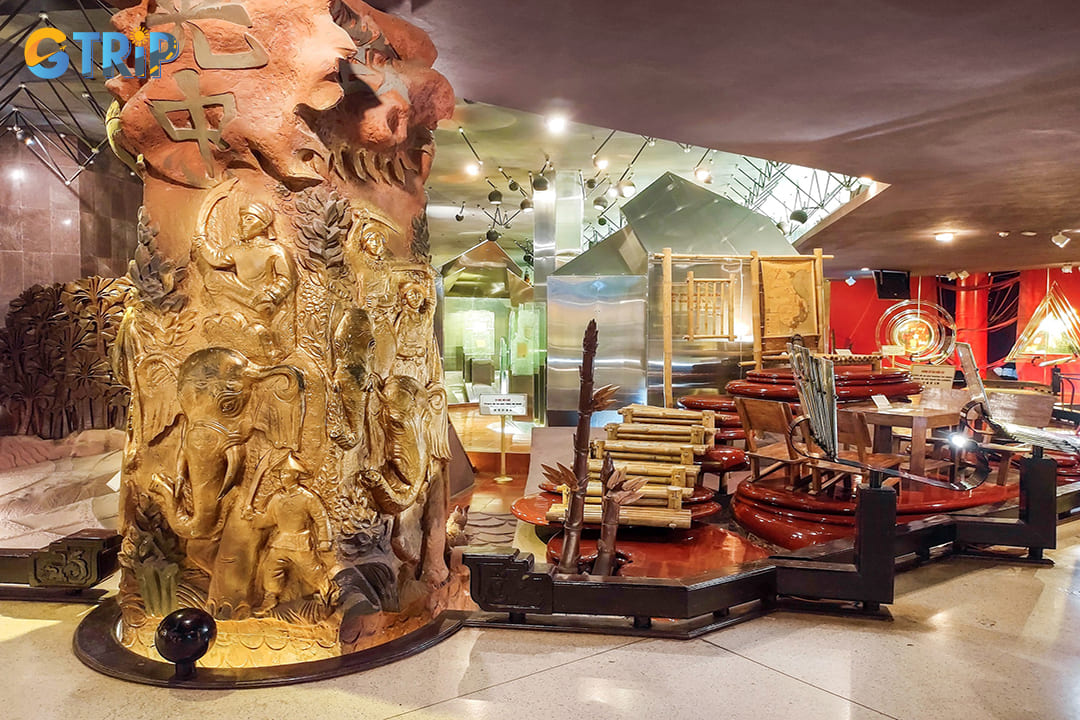
The Ho Chi Minh Museum is a vast historical repository dedicated to the life and legacy of Vietnam’s revolutionary leader
Opening hours & entrance fee:
- Opening hours
| Day | Morning | Afternoon | Notes |
|---|---|---|---|
| Monday | Closed | Closed | |
| Tuesday - Thursday | 8:00 AM - 12:00 PM | 2:00 PM - 4:30 PM | Regular hours |
| Friday | Closed | Closed | |
| Saturday - Sunday | 8:00 AM - 12:00 PM | 2:00 PM - 4:30 PM | Regular hours |
- Entrance fee: International tourists are charged 40,000 VND per person, entry is free for Vietnamese citizens, disabled individuals, and ICOM members.
3. Ho Chi Minh’s Stilt House
Located at 1 Hoang Hoa Tham Street, Doi Can Ward, Ba Dinh District, Hanoi, Ho Chi Minh’s Stilt House is a powerful symbol of his humility and dedication to the Vietnamese people. Built in 1958, this small wooden structure (measuring approximately 10.5m x 6.2m) served as his home and workplace until his passing in 1969. The house stands in stark contrast to the colonial grandeur of the nearby Presidential Palace, embodying Ho Chi Minh’s preference for a simple, modest lifestyle.
The stilt house remains well-preserved, offering a rare glimpse into Ho Chi Minh’s daily life. Inside, the furnishings are minimal: a rattan bed, wooden desk, bookshelves, and basic wooden chairs. His personal belongings, including handwritten notes and work materials, provide insight into his disciplined and frugal way of living.
Architecturally, the house follows the traditional stilt-house design of rural Vietnam, reflecting Ho Chi Minh’s deep connection with ordinary citizens and indigenous culture. Elevated on wooden stilts, it represents practicality and harmony with nature, a stark contrast to the opulent buildings of Vietnam’s colonial past.
Stepping into the stilt house and its tranquil surroundings, you can experience a more personal side of Ho Chi Minh. He is not just a political leader, but a man who lived simply and devotedly. The house’s peaceful gardens and fish pond add to the serene atmosphere, making it a place of reflection and historical appreciation for those seeking a deeper understanding of Vietnam’s most revered leader.
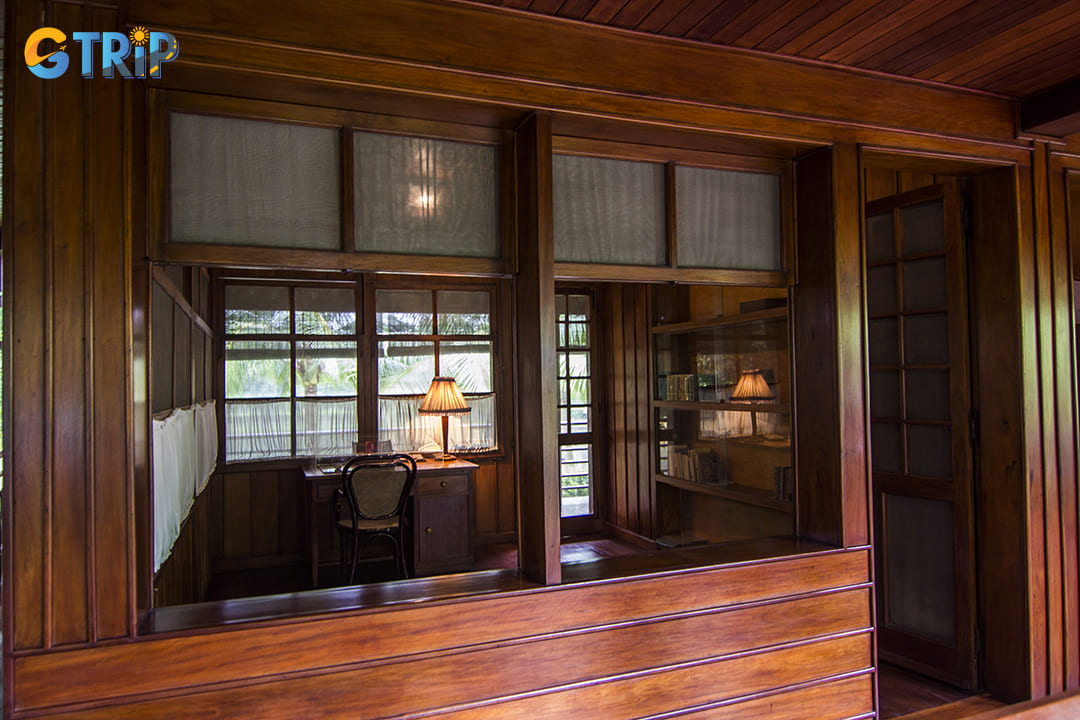
The stilt house remains well-preserved, offering a rare glimpse into Ho Chi Minh’s daily life
Opening hours & entrance fee:
- Opening hours
| Day | Morning hours | Afternoon hours | Notes |
|---|---|---|---|
| Monday | 7:30 AM - 11:00 AM | Closed | Open in the morning only |
| Tuesday - Thursday | 7:30 AM - 11:00 AM | 1:30 PM - 4:00 PM | |
| Friday | 7:30 AM - 11:00 AM | 1:30 PM - 4:00 PM | |
| Saturday - Sunday | 7:30 AM - 11:00 AM | 1:30 PM - 4:00 PM |
- Entrance Fee: Free for all Vietnamese, 25,000 VND/foreign tourist.
4. Presidential Palace Historical Site
Located at 2 Hung Vuong Street, Ngoc Ha Ward, Ba Dinh District, Hanoi, the Presidential Palace Historical Site tells a compelling story of Vietnam’s transition from colonial rule to self-governance. Originally constructed as the residence of the French Governor-General of Indochina, the palace’s grand French colonial architecture stands in stark contrast to Ho Chi Minh’s philosophy of simplicity and humility. Despite its ornate design and imported materials, Ho Chi Minh chose not to live in it, opting instead for a more modest residence within the complex.
Built in the early 20th century, the Presidential Palace is a prime example of French colonial opulence, featuring intricate details, European-style facades, and grand interiors. The palace was designed to symbolize colonial power and luxury, yet after Vietnam’s independence, it remained largely a government venue rather than a residence for the country’s leader.
Within the complex, two notable structures highlight Ho Chi Minh’s personal history:
- House No. 54, a simple, two-room house, was where Ho Chi Minh lived from 1954 to 1958 before moving to his stilt house.
- House No. 67, a war-time meeting place, served as a critical site where Ho Chi Minh held discussions during the Vietnam War.
These modest structures provide deeper insight into his leadership style and commitment to the people.
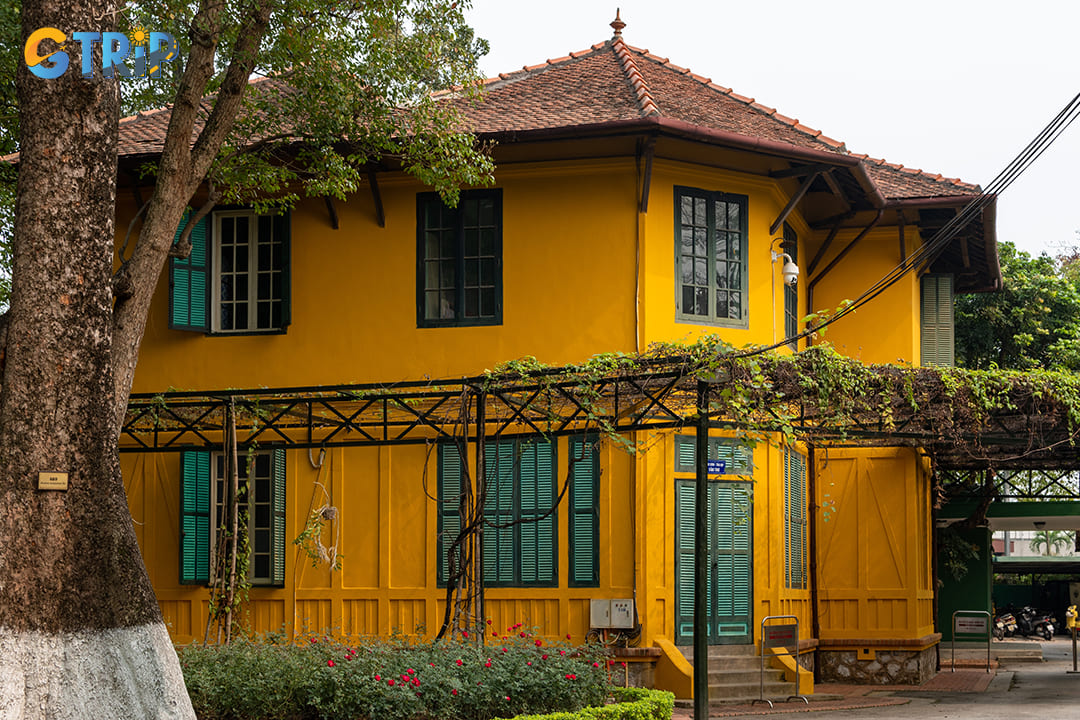
Within the complex, two notable structures that highlight Ho Chi Minh’s personal history are House No. 54 and House No. 67
Opening hours & entrance fee:
- Opening hours
| Season | Days open | Morning hours | Afternoon hours |
|---|---|---|---|
| Summer (April - October) | Tuesday - Thursday, Saturday - Sunday | 7:30 AM - 11:00 AM | 1:30 PM - 4:00 PM |
| Winter (November - March) | Tuesday - Thursday, Saturday - Sunday | 8:00 AM - 11:00 AM | 1:30 PM - 4:00 PM |
- Entrance Fee: Free for the Vietnamese; 40,000 VND for foreign tourists.
5. Ba Dinh Square
Located at 2 Hung Vuong Street, Ngoc Ha Ward, Ba Dinh District, Hanoi, Ba Dinh Square is one of Vietnam’s most historically significant public spaces. It was here, on September 2, 1945, that Ho Chi Minh proclaimed Vietnam’s independence, marking the birth of the Democratic Republic of Vietnam. Today, the square remains a powerful symbol of national unity and resilience.
Ba Dinh Square has played a pivotal role in Vietnam’s modern history, serving as the backdrop for Independence Day celebrations, military parades, and state ceremonies. It continues to be a site for official gatherings and national commemorations, reinforcing its status as a place of profound historical importance.
Each day, the square hosts the flag-raising ceremony at dawn and the flag-lowering ceremony at dusk, performed by an honor guard in front of the Ho Chi Minh Mausoleum. These rituals carried out with precision and solemnity, serve as a daily reminder of Vietnam’s independence and patriotic spirit.
Spanning approximately 320 meters by 100 meters, Ba Dinh Square is the largest public square in Vietnam. Its vast open spaces and well-manicured lawns can accommodate up to 20,000 people, making it the focal point for national celebrations, commemorative events, and public gatherings. You can walk through the square, take in its historical significance, and witness the daily ceremonies, all while surrounded by some of Hanoi’s most important landmarks.
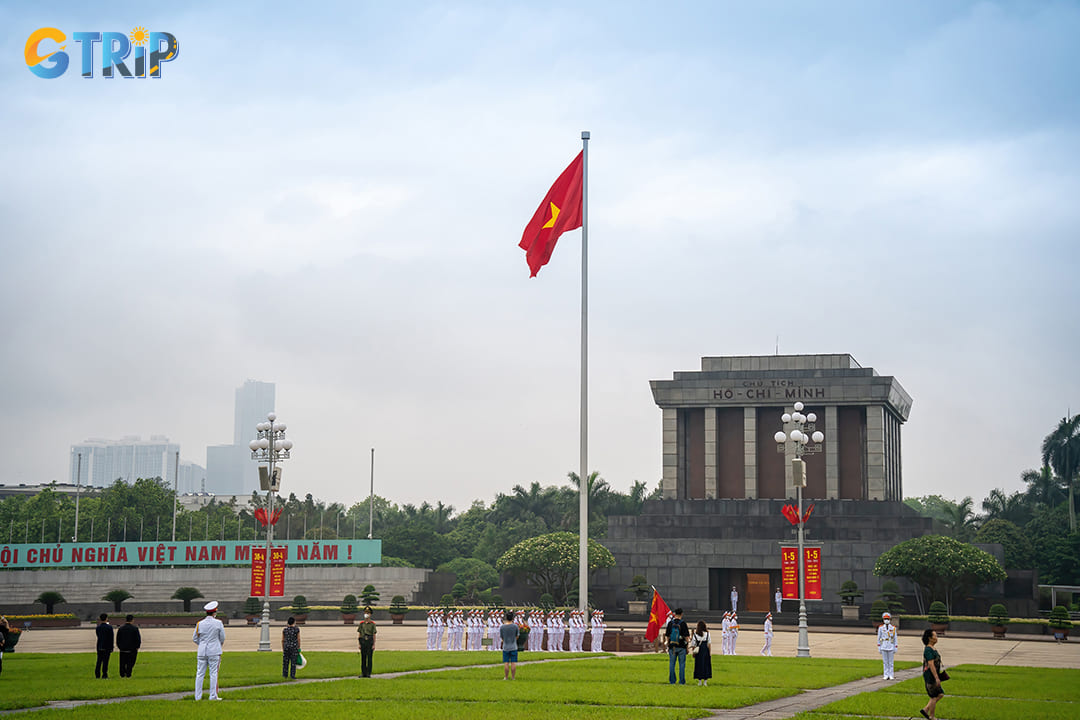
Each day, the square hosts the flag-raising ceremony at dawn and the flag-lowering ceremony at dusk
Opening hours, flag ceremonies & entrance fee:
- Opening hours and flag ceremonies
| Season | Square opening hours | Flag-raising ceremony | Flag-lowering ceremony |
|---|---|---|---|
| Summer (April - October) | 5:00 AM - 10:00 PM | 6:00 AM | 9:00 PM |
| Winter (November - March) | 5:00 AM - 10:00 PM | 6:30 AM | 9:00 PM |
- Entrance Fee: Free entry, as it is a public area.
6. One Pillar Pagoda
Nestled in Chua Mot Cot ward, Doi Can, Ba Dinh, Hanoi, the One Pillar Pagoda is one of Vietnam’s most iconic Buddhist temples. Dating back to the Ly Dynasty in 1049, the pagoda has undergone multiple restorations, yet it continues to embody deep spiritual and cultural significance. Its distinctive single-pillar design, resembling a lotus flower rising from water, symbolizes purity, rebirth, and enlightenment.
Unlike the larger, more formal monuments in the Ho Chi Minh Complex, the One Pillar Pagoda captivates with its elegant simplicity. Supported by a single stone pillar, the pagoda’s wooden shrine is a masterful example of traditional Vietnamese architecture. The lotus-inspired design draws from Buddhist symbolism, reflecting themes of renewal and spiritual awakening.
Beyond its architectural charm, the One Pillar Pagoda holds deep spiritual significance for Buddhists and history enthusiasts alike. It stands as a symbol of Vietnam’s enduring cultural and religious heritage, offering you a moment of reflection and connection amid the historically charged surroundings of Ba Dinh District. Its presence within the Ho Chi Minh Complex highlights the harmonious coexistence of politics, history, and spirituality in Vietnam.
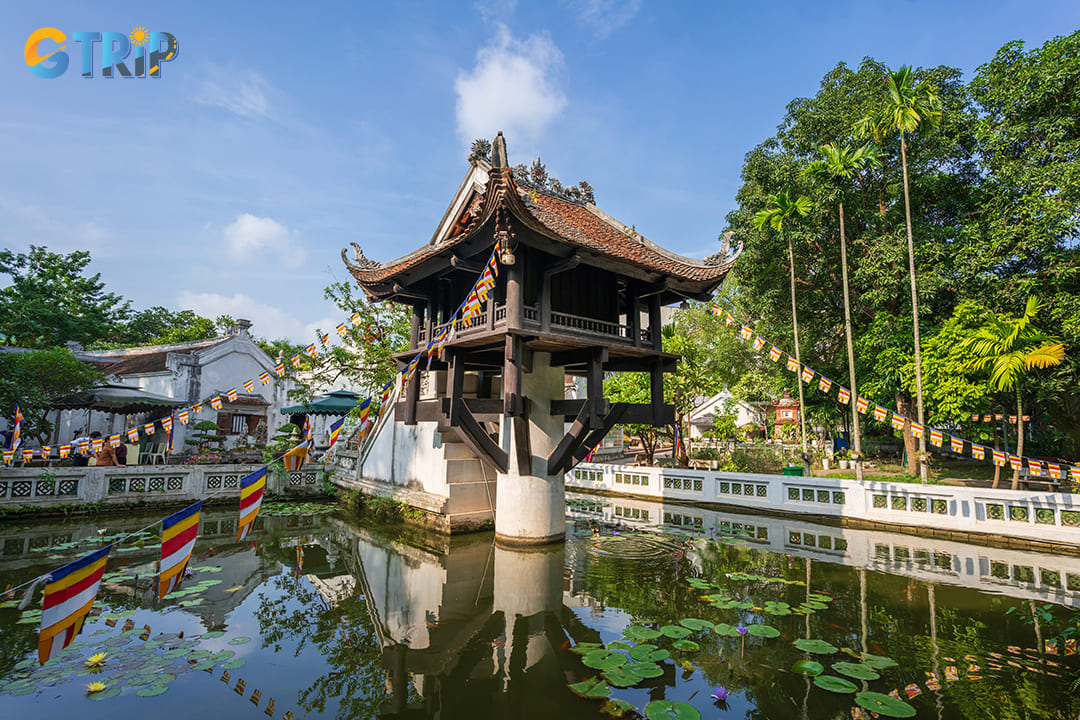
The One Pillar Pagoda is one of Vietnam’s most iconic Buddhist temples
Opening hours & entrance fee:
- Opening hour: The pagoda is accessible daily from 7:00 AM to 6:00 PM.
- Entrance fee: Free for Vietnamese, foreign tourists are charged 25,000 VND per person.
Together, these landmarks form a cohesive narrative of Vietnam’s revolutionary journey and the enduring legacy of Ho Chi Minh. Each site offers a unique window into the nation’s past and provides practical, visitor-friendly information that enhances the overall travel experience. This balanced presentation of historical data, architectural insights, and up-to-date visitor details ensures that the complex educates and inspires those who come to explore it.
How to get to the Complex of President Ho Chi Minh?
The Complex of President Ho Chi Minh is easily accessible via various transportation methods, including public transit, private vehicles, and even walking for nearby tourists. Depending on your location and budget, you can choose from buses, taxis, ride-hailing services, or personal transport. Below is a detailed transportation guide to help you find the best way to reach this historic landmark efficiently.
By bus
Hanoi’s public bus system is an economical and convenient way to reach the Ho Chi Minh Complex, with fares starting at 7,000 VND (~$0.30) per ride. Several bus routes pass near Ba Dinh Square, Ngoc Ha Street, and Le Hong Phong Street - major access points to the complex such as Bus 09, Bus 22, Bus 33, or Bus 50.
How to use the bus in Hanoi:
- Board the bus at a designated stop and pay directly to the conductor or use a Hanoi Bus Card for a cashless experience.
- Follow your route using Google Maps or the BusMap app for real-time tracking.
- Get off at stops near Ba Dinh Square, Le Hong Phong Street, or Ngoc Ha Street, all within a 5 - 7 minute walking distance to the complex.
- To avoid crowded buses, plan your trip outside of peak hours (7:30 AM - 9:00 AM & 4:30 PM - 6:30 PM).
For the most accurate and up-to-date bus routes, check the BusMap app or official Hanoi bus websites before your trip.
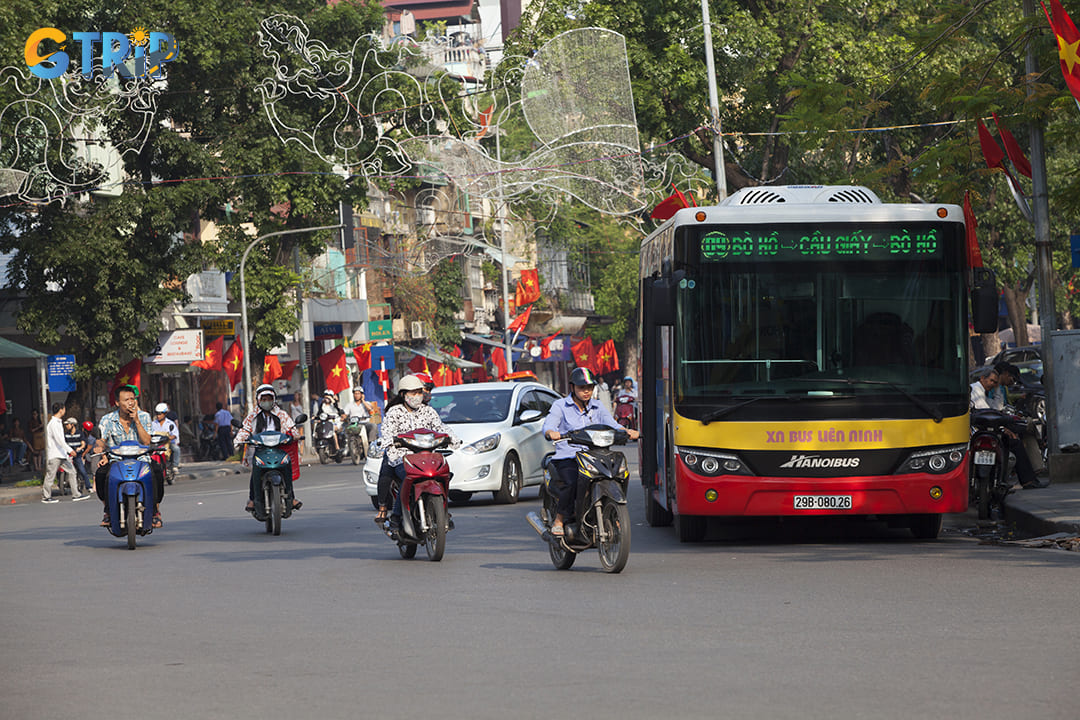
Hanoi’s public bus system is an economical and convenient way to reach the Ho Chi Minh Complex
By taxis & ride-hailing services
For convenience and direct access, taxis and ride-hailing services are widely available in Hanoi. You can choose Hanoi’s reputable taxi companies, which offer metered fares and air-conditioned vehicles:
| Taxi company | Contact number | Estimated fare from Hoan Kiem |
|---|---|---|
| Mai Linh Taxi | +84 24 38 333 333 | ~50,000 - 100,000 VND ($1.96 - $4.50) |
| Vinasun Taxi | +84 24 3827 2727 | ~65,000 - 110,000 VND ($2.54 - $5.00) |
| G7 Taxi | +84 24 3232 3232 | ~45,000 - 95,000 VND ($1.76 - $4.20) |
- Pros: Convenient, available 24/7, suitable for groups.
- Cons: Higher cost, potential for overcharging (always request a meter).
Ride-hailing apps
For cashless transactions and fixed fares, consider using Vietnam’s popular ride-hailing apps:
| App | Vehicle options | Estimated fare (Hoan Kiem → Ho Chi Minh Complex) |
|---|---|---|
| Grab | Bike, car, 7-seater | 40,000 - 90,000 VND ($1.70 - $3.80) |
| Xanh SM | Bike, car | 45,000 - 95,000 VND ($1.90 - $4.00) |
| Be | Bike, car | 38,000 - 92,000 VND ($1.60 - $4.00) |
- Pro tip: Use promo codes for discounts, especially during off-peak hours.
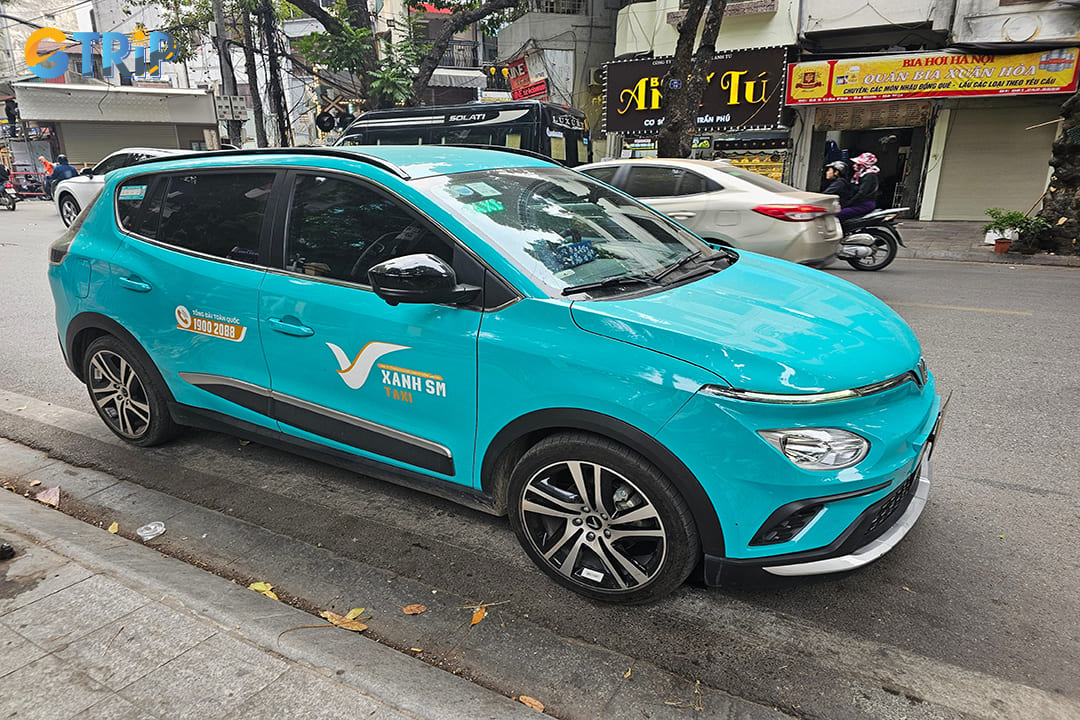
For cashless transactions and fixed fares, consider using Vietnam’s popular ride-hailing apps
By private vehicles
Tourists using motorbikes, bicycles, or private cars can park at designated locations near the complex.
Motorbike & bicycle parking
- Ngoc Ha Parking Lot (Ngoc Ha Street, opposite Ho Chi Minh Museum): Around 5,000 - 10,000 VND per bike ($0.20 - $0.40)
- Le Hong Phong Parking Area (Near Ba Dinh Square, official parking): Around 10,000 VND - 15,000 VND per bike ($0.40 - $0.60)
Car parking options
- Ong Ich Khiem Parking Lot (Near One Pillar Pagoda): 40,000 VND per car (~$1.70)
- Tran Phu Parking Area (10-minute walk from the complex): 50,000 VND per car (~$2.10)
Note: The price may change, so come to the experience; but the parking price will not be too high.
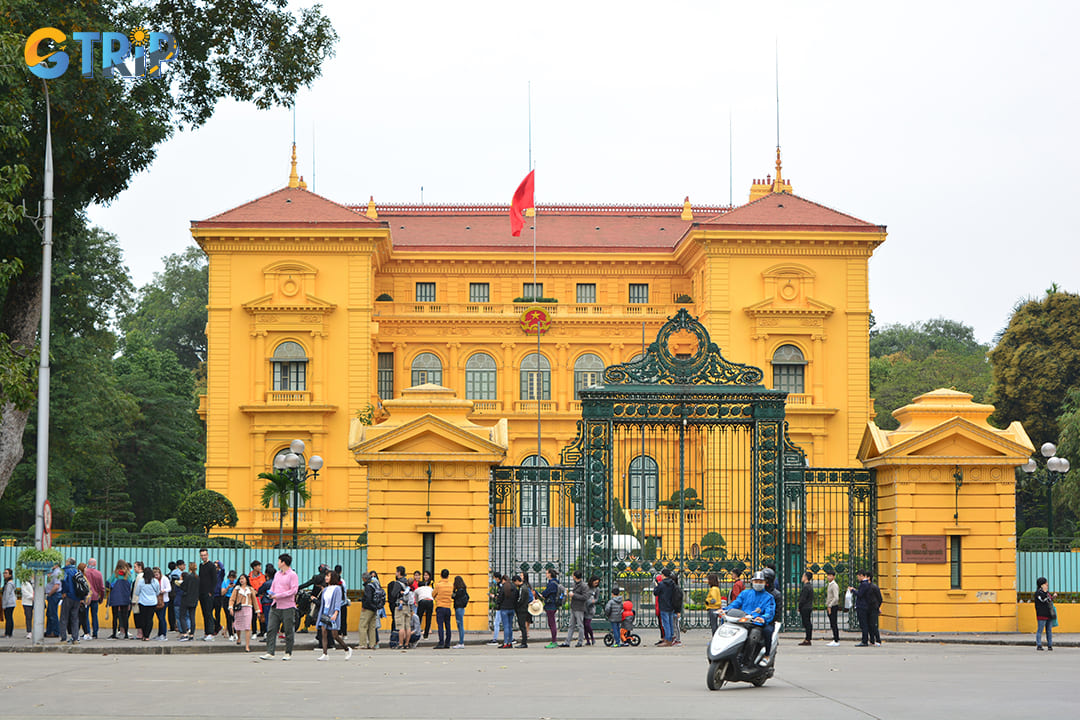
Tourists using motorbikes, bicycles, or private cars can park at designated locations near the complex
By walk
For tourists staying in central Ba Dinh or Hoan Kiem, walking is a scenic and convenient way to reach the Complex of President Ho Chi Minh.
| Starting point | Distance | Walking time |
|---|---|---|
| Hoan Kiem Lake | ~2.5 km | ~40 minutes |
| Imperial Citadel of Thang Long | ~1.5 km | ~30 minutes |
| One Pillar Pagoda | ~400 meters | ~5 minutes |
| Vietnam Military History Museum | ~1.2 km | ~20 minutes |
- Pro tip: Mornings (before 9:00 AM) or late afternoons (after 4:00 PM) are ideal for walking to avoid the midday heat.
Practical travel guide for visitors
To fully experience the site while avoiding common pitfalls, careful planning is essential. This guide provides practical insights to help tourists optimize their trip, covering the best visiting times, dress codes, visitor regulations, and recommended itineraries.
The best time to visit the Complex of President Ho Chi Minh
Choosing the right time to visit the Complex of President Ho Chi Minh can significantly impact your experience. Consider both seasonal weather conditions and daily visitor patterns to avoid long queues and discomfort.
Seasonal considerations
Hanoi’s weather varies dramatically throughout the year, affecting tourists experience:
| Season | Weather & travel tips |
|---|---|
| Spring (March - April) | Pleasant temperatures, and moderate crowds. Ideal for comfortable sightseeing. |
| Summer (May - August) | Hot and humid, with occasional heavy rains. The heat can be overwhelming, so morning visits are recommended. |
| Autumn (September - November) | Mild temperatures and clear skies create ideal conditions. |
| Winter (December - February) | Chilly, but mostly dry. Crowds peak during Vietnamese New Year (Tet), so avoid this period if you wish for a quieter visit. |
Best hours of the day
To avoid long queues and extreme weather, early morning visits are recommended:
- Ho Chi Minh Mausoleum: Arrive before 7:00 AM to secure a good spot in line.
- Other sites (Museum, Stilt House, Presidential Palace): Best visited in the late morning or early afternoon.
- Peak tourist hours: 9:00 AM - 10:30 AM, especially on weekends. Arriving outside this window ensures a smoother experience.
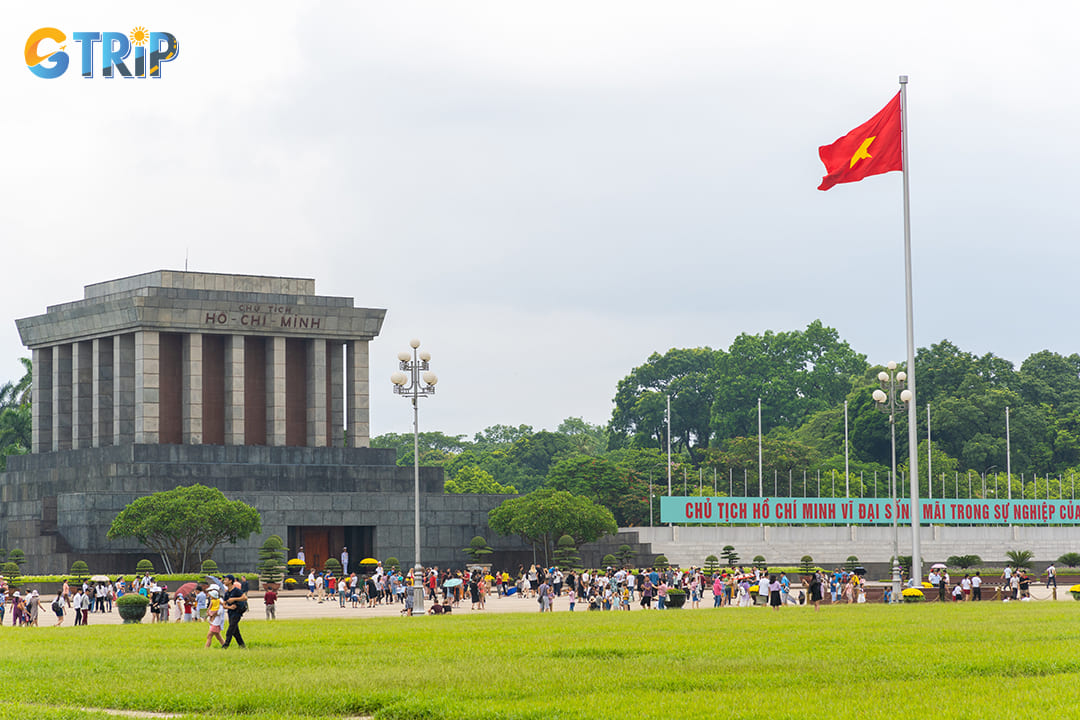
To avoid long queues and extreme weather, early morning visits are recommended
Dress code & visitor rules
As a site of historical and national importance, tourists are expected to follow strict etiquette and dress regulations.
Mausoleum restrictions
- No photography or videography inside the Ho Chi Minh Mausoleum.
- Strict silence is required inside the mausoleum. Security personnel enforce this rule strictly.
- No large bags, hats, or food and drinks are allowed. Bags may need to be checked at the entrance.
General guidelines
You should dress respectfully and conservatively, following guidelines similar to those for temples and official government sites.
Appropriate attire:
- Long pants or knee-length skirts
- Shirts with sleeves (no tank tops)
- Closed-toe shoes preferred
Prohibited attire:
- Shorts, mini-skirts, sleeveless tops
- Flip-flops, excessively casual footwear
Behavior expectations:
- Follow designated walking paths and queue lines for an orderly experience.
- Speak softly, particularly in memorial areas like the mausoleum and stilt house.
- Refrain from touching artifacts or structures unless permitted.

You should dress respectfully and conservatively to those for temples and official government sites
Recommended itineraries
The Complex of President Ho Chi Minh is vast, and your itinerary should be tailored based on available time. Here are two recommended plans:
Half-day tour (2.5 - 3 hours)
Best for: Tourists with limited time who want to experience the highlights.
- 7:00 AM - 8:30 AM: Ho Chi Minh Mausoleum
- Arrive early to avoid long queues.
- Observe the changing of the guard's ceremony.
- 8:30 AM - 9:00 AM: Ho Chi Minh’s Stilt House
- See Ho Chi Minh’s simple lifestyle and work area.
- 9:00 AM - 9:30 AM: Presidential Palace & Gardens
- Explore the French colonial architecture and scenic grounds.
- 9:30 AM - 10:30 AM: Ho Chi Minh Museum
- Quick overview of key historical artifacts and exhibitions.
Full-day experience (5 - 6 hours)
Best for: History enthusiasts who want an in-depth visit.
- 7:00 AM - 8:30 AM: Ho Chi Minh Mausoleum
- Arrive early for a peaceful experience.
- 8:30 AM - 9:30 AM: Ho Chi Minh’s Stilt House & Presidential Palace
- Walk through the gardens and visit House No. 54 and House No. 67.
- 9:30 AM - 10:30 AM: Ho Chi Minh Museum
- Detailed exploration of exhibits showcasing Ho Chi Minh’s life.
- 10:30 AM - 11:00 AM: One Pillar Pagoda
- Visit the famous Buddhist temple located nearby.
Lunch break (11:30 AM - 1:30 PM) - Consider trying authentic Hanoi cuisine at restaurants near the complex.
- 1:30 PM - 3:00 PM: Ba Dinh Square & nearby attractions
- Take photos, and observe the national flag-raising/lowering ceremony (6:00 AM / 9:00 PM).
- 3:00 PM - 4:30 PM: Optional nearby attractions
- Vietnam Military History Museum (5 minutes away).
- Temple of Literature (10 minutes away).
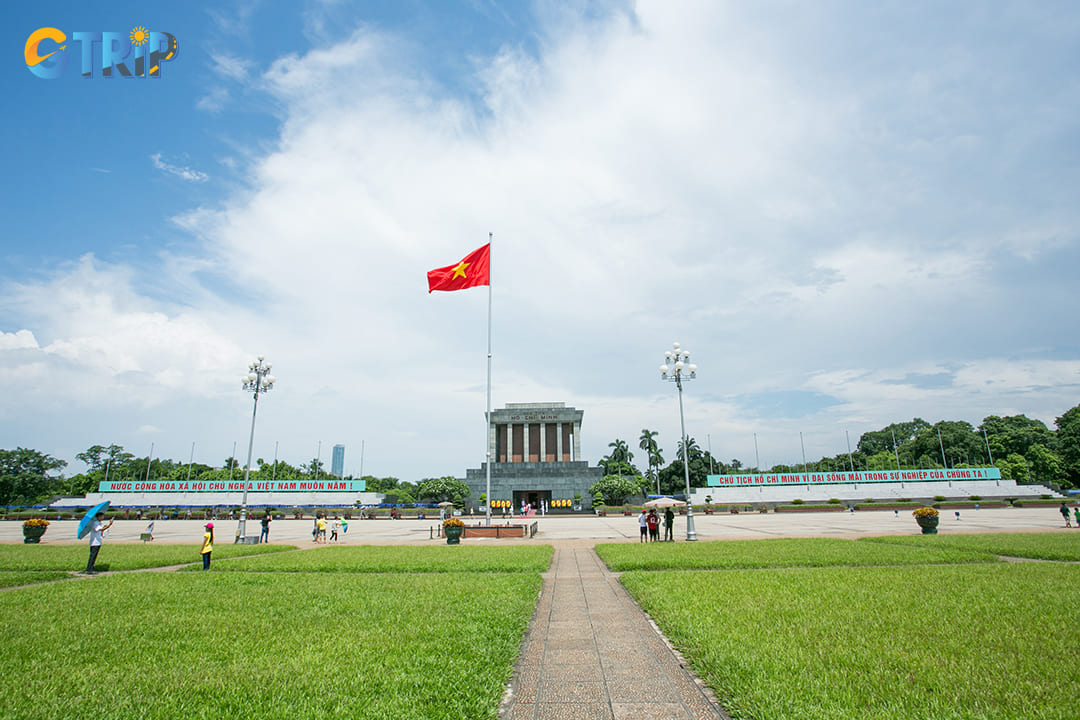
The Complex of President Ho Chi Minh is vast, and your itinerary should be tailored based on available time
Nearby attractions from the Complex of President Ho Chi Minh
The Complex of President Ho Chi Minh is located in a a historically rich area filled with significant landmarks that reflect Vietnam’s heritage, political history, and cultural legacy. Tourists exploring the complex can enhance their itinerary by visiting several nearby attractions, all within a short walking or driving distance. These sites provide deeper insight into Hanoi’s past and present, making them essential stops for history enthusiasts, culture seekers, and travelers alike.
1. Vietnam Fine Arts Museum (Bao tang My thuat Viet Nam)
Located just 1 km from the Ho Chi Minh Complex, the Vietnam Fine Arts Museum is a 5-minute drive or a 15-minute walk away. For those interested in Vietnamese culture and artistic heritage, the Vietnam Fine Arts Museum offers an extensive collection of paintings, sculptures, and folk art spanning different historical periods. The museum features artifacts from the Dong Son culture (700 - 500 BCE), showcasing Vietnam’s early civilization through intricate bronze drums, carvings, and relics. These artifacts provide valuable insights into the craftsmanship and cultural practices of ancient Vietnamese societies.
A collection of propaganda posters and socialist realism paintings captures Vietnam’s struggle for independence. These works serve as powerful visual narratives of the country's revolutionary movements, highlighting themes of resistance, patriotism, and national pride. The museum showcases intricate lacquer paintings, ceramics, and folk art, reflecting Vietnam’s rich handicraft traditions. These exhibits celebrate centuries-old artistic techniques, emphasizing the craftsmanship that has been passed down through generations. With its blend of ancient artifacts, revolutionary art, and traditional handicrafts, the Vietnam Fine Arts Museum offers you a comprehensive look at Vietnam’s artistic and cultural legacy.
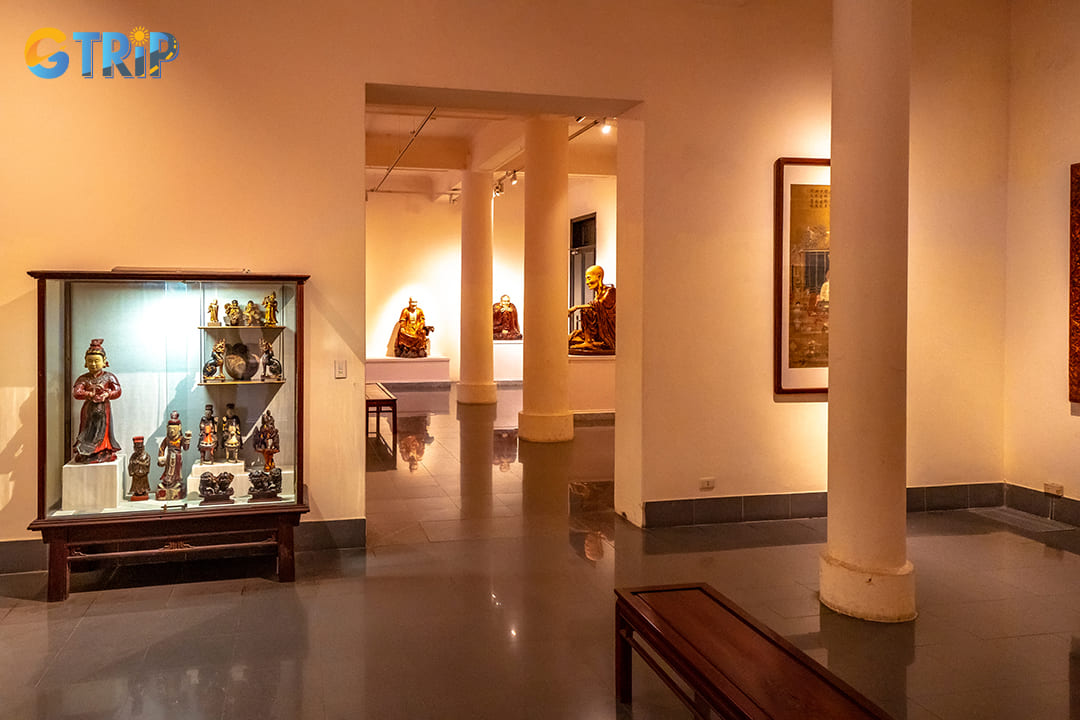
The Vietnam Fine Arts Museum offers an extensive collection of paintings, sculptures, and folk art spanning different historical periods
2. Imperial Citadel of Thang Long (Hoang Thanh Thang Long)
Located just 1 km from the Ho Chi Minh Complex, the Imperial Citadel of Thang Long is a 5-minute drive or a 15-minute walk away. A UNESCO World Heritage Site, the Imperial Citadel of Thang Long served as the political center of Vietnam for over 1,300 years. It contains archaeological remains from different dynasties and offers insights into Hanoi’s historical role as Vietnam’s capital. The site houses artifacts from the Ly, Tran, and Le dynasties, some dating as far back as the 7th century. These relics include stone foundations, ceramics, and imperial structures, reflecting the architectural and cultural influences of different eras. During the French colonial period, parts of the citadel were repurposed for military use. You can explore underground bunkers and command posts that were utilized during the First Indochina War and the Vietnam War.
In 2010, the Imperial Citadel was designated a UNESCO World Heritage Site, acknowledging its cultural and historical significance. This recognition highlights the citadel’s role in shaping Vietnam’s identity and its enduring legacy as a political and military stronghold. For a more comfortable experience, it’s best to visit early in the morning or late in the afternoon to avoid the midday heat. The open courtyards and historical ruins make for a fascinating exploration, offering both historical insights and stunning photography opportunities.
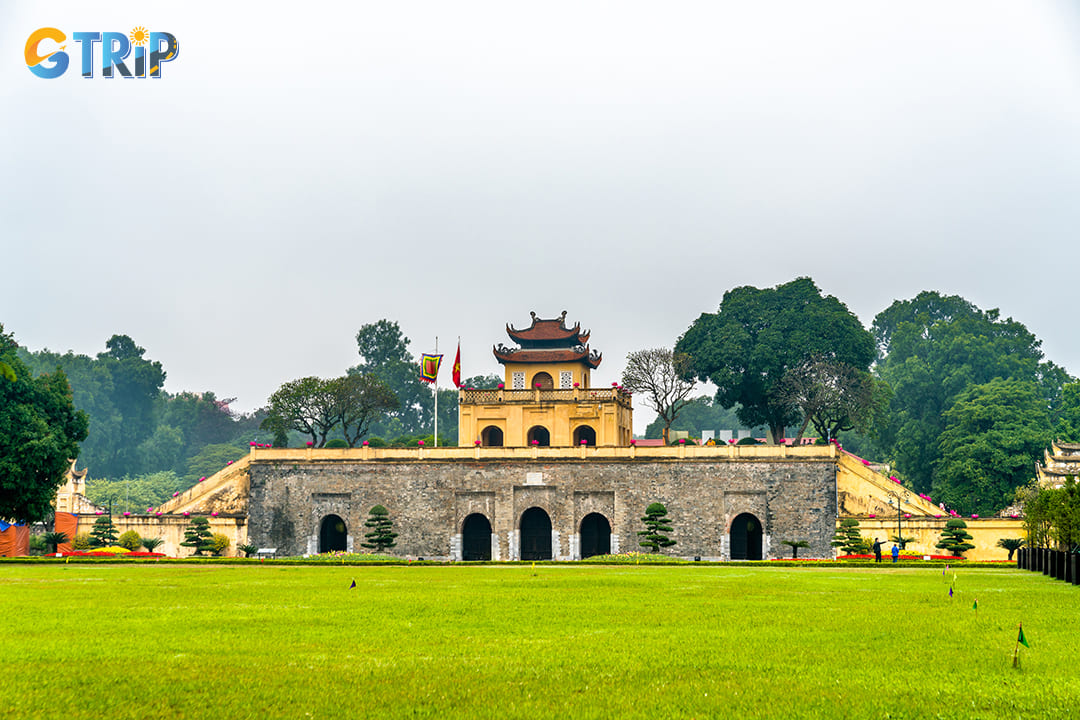
The Imperial Citadel of Thang Long served as the political center of Vietnam for over 1,300 years
3. Temple of Literature (Van Mieu - Quoc Tu Giam)
Located 1.4 km from the Ho Chi Minh Complex, the Temple of Literature is a 7-minute drive or a 20-minute walk away. The Temple of Literature is Vietnam’s first national university, founded in 1070 by Emperor Ly Thanh Tong. It is dedicated to Confucius and has long been a symbol of academic excellence in Vietnam.
The Quoc Tu Giam (Imperial Academy) was Vietnam’s first institution for higher education, where scholars trained for the imperial examination system. It played a crucial role in shaping Vietnam’s intellectual and administrative elite. The temple houses 82 stone stelae, each engraved with the names of scholars who successfully passed the rigorous imperial exams. These stelae, recognized by UNESCO, offer valuable historical insights into Vietnam’s ancient education system and honor generations of learned individuals.
The Temple of Literature is a well-preserved example of Vietnamese traditional architecture, featuring serene courtyards, lotus ponds, and lush gardens. Its harmonious layout provides a peaceful retreat from the bustling city, making it an ideal place for reflection and cultural appreciation. The temple is particularly lively during graduation season, as students come here to take photos and seek blessings for their academic success. Visiting during this time offers a unique glimpse into modern Vietnamese traditions intertwined with historical heritage.
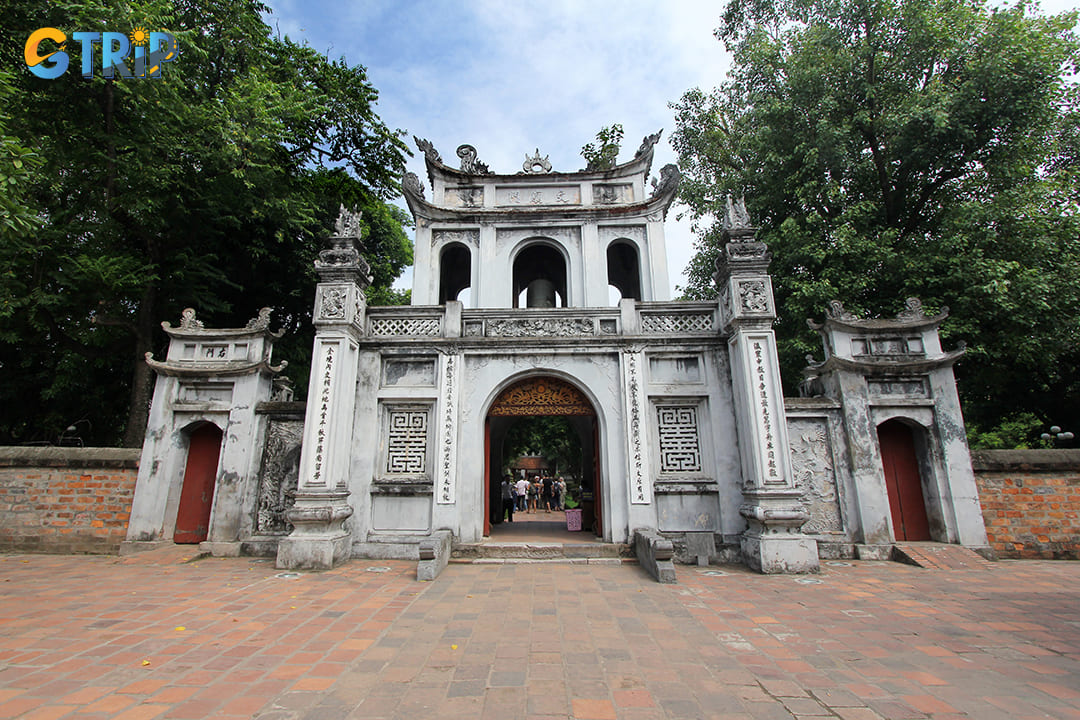
Temple of Literature is dedicated to Confucius and has long been a symbol of academic excellence in Vietnam
FAQs about the Complex of President Ho Chi Minh
Visiting the Complex of President Ho Chi Minh in Hanoi is a must for history enthusiasts and travelers seeking to understand Vietnam’s revolutionary past. However, many first-time tourists have common questions about the site’s logistics, rules, and nearby attractions. Below, we address the most frequently asked queries to help you plan a seamless visit.
How long does it take to explore the entire complex?
The time needed to fully explore the Complex of President Ho Chi Minh depends on several factors. You should consider the visitor’s pace, interest levels, and waiting times at key attractions like the Ho Chi Minh Mausoleum.
Estimated time breakdown for each landmark:
| Attraction | Time required | Notes |
|---|---|---|
| Ho Chi Minh Mausoleum | 30 - 45 minutes | Includes queue time, security checks, and the brief walk through the chamber. |
| Ho Chi Minh Museum | 60 - 90 minutes | Offers in-depth exhibits on Ho Chi Minh’s life and Vietnam’s independence movement. |
| Ho Chi Minh’s Stilt House & Presidential Palace Area | 45 - 60 minutes | You can explore the stilt house, gardens, and nearby structures. |
| Ba Dinh Square | 15 - 30 minutes | Best experienced during flag-raising or lowering ceremonies. |
| One Pillar Pagoda | 10 - 20 minutes | A quick stop to admire the historic Buddhist site. |
Total estimated visit duration:
- Fast-paced visit: 2-3 hours (covering key sites briefly).
- In-depth exploration: 4-5 hours (ideal for history and culture enthusiasts).
- Full-day experience: If combined with other nearby attractions like the Vietnam Military History Museum or Temple of Literature.
Tourists should plan their visit around the mausoleum’s strict opening hours (typically mornings only) to ensure access to all sites within the complex.
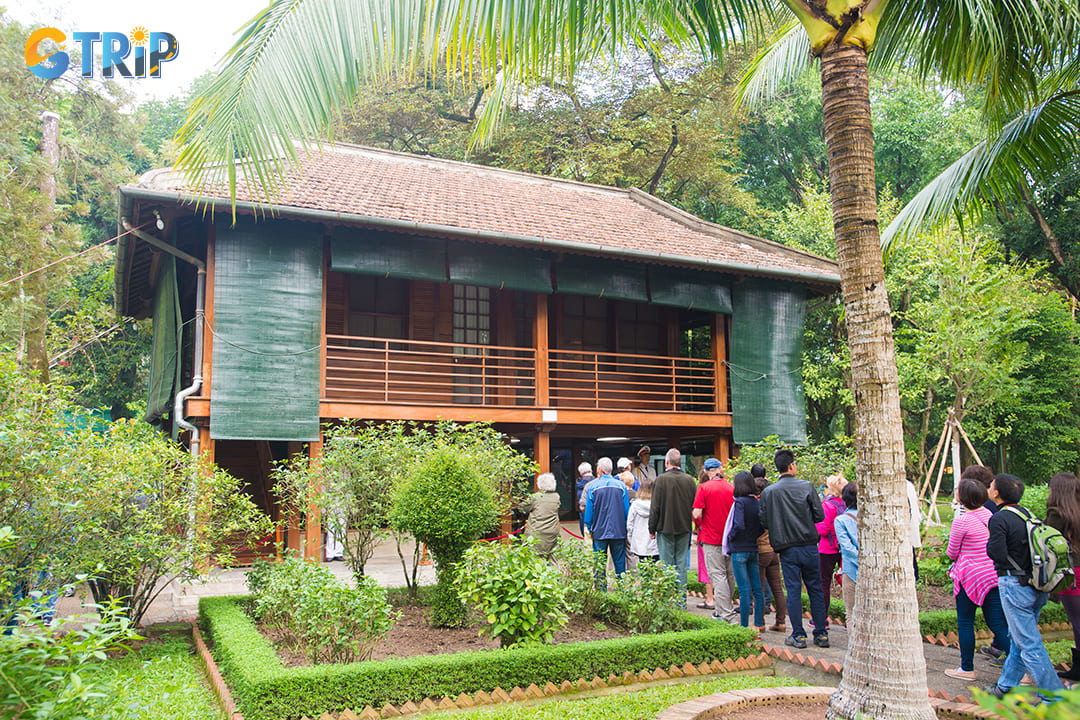
The time needed to fully explore the Complex of President Ho Chi Minh depends on several factors
Can I take photos inside the Ho Chi Minh Mausoleum?
No, photography is strictly prohibited inside the Ho Chi Minh Mausoleum. This rule is enforced to maintain a solemn atmosphere and preserve the embalmed body of President Ho Chi Minh.
Photography rules at the complex:
| Location | Photography allowed? | Notes |
|---|---|---|
| Inside the Ho Chi Minh Mausoleum | No | Security personnel will instruct tourists to put away cameras and phones. |
| Outside the Mausoleum | Yes | You can take photos in front of the building and at Ba Dinh Square. |
| Ho Chi Minh’s Stilt House & Gardens | Yes | Photography is permitted but drones are not allowed. |
| Ho Chi Minh Museum | Limited | Some exhibition areas allow photography, but flash photography may be restricted. |
| Presidential Palace & One Pillar Pagoda | Yes | Photos are allowed in open areas but not inside restricted government buildings. |
Violating these rules can result in confiscation of equipment or being escorted out by security. It is best to follow all posted signs and instructions from staff members to ensure a respectful visit.
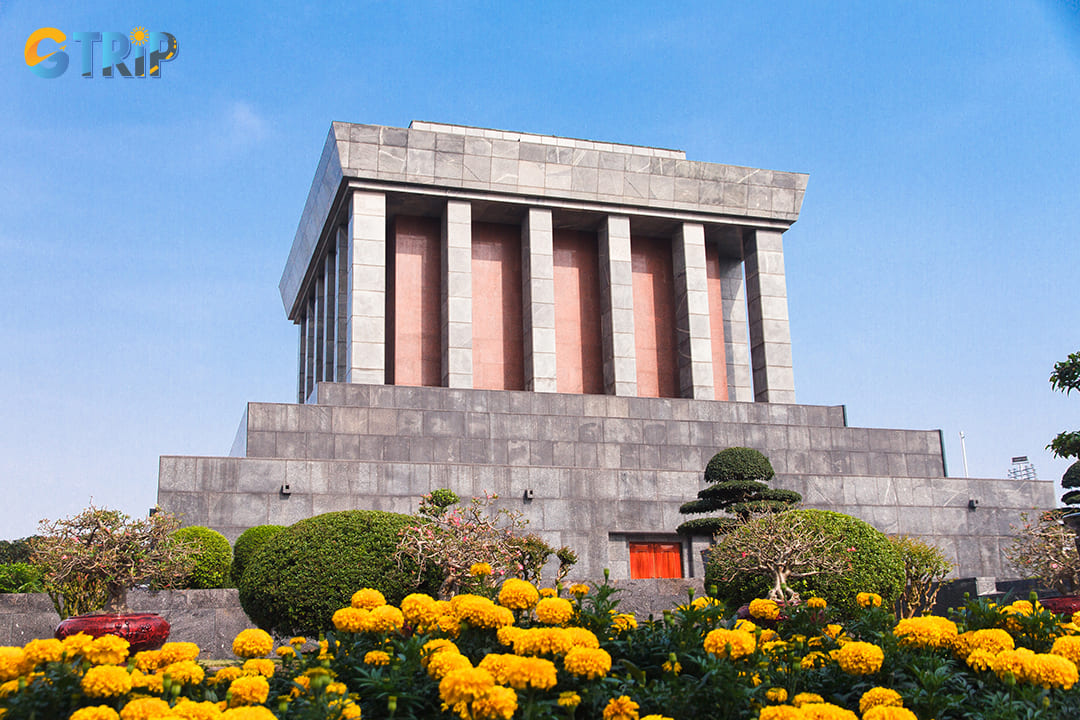
Photography is strictly prohibited inside the Ho Chi Minh Mausoleum
Is there an English-speaking guide available?
Yes, English-speaking guides are available within the Complex of President Ho Chi Minh, but availability may depend on tourist demand and prior booking.
Options for guided tours:
- Official on-site guides: The Ho Chi Minh Museum and Stilt House area offer government-appointed guides who provide English tours for individuals or groups. These guides are well-trained in historical facts but may have limited availability.
- Private tour guides: Several Hanoi-based tour companies offer pre-arranged private guides who provide more personalized insights and allow for flexible itineraries.
- Audio guides & self-guided tours: Some sections, such as the museum, have informational panels in English, and you can use self-guided tour apps for an independent experience.
To ensure an English-speaking guide, it is advisable to:
- Book through a local travel agency before your visit.
- Arrive early and inquire at the museum or main entrance about available guides.
- Check with your hotel concierge for reputable tour recommendations.
Average tour cost: Private guides range from 200,000 VND to 766,000 VND ($7.83 - $30) per person, depending on duration and group size.
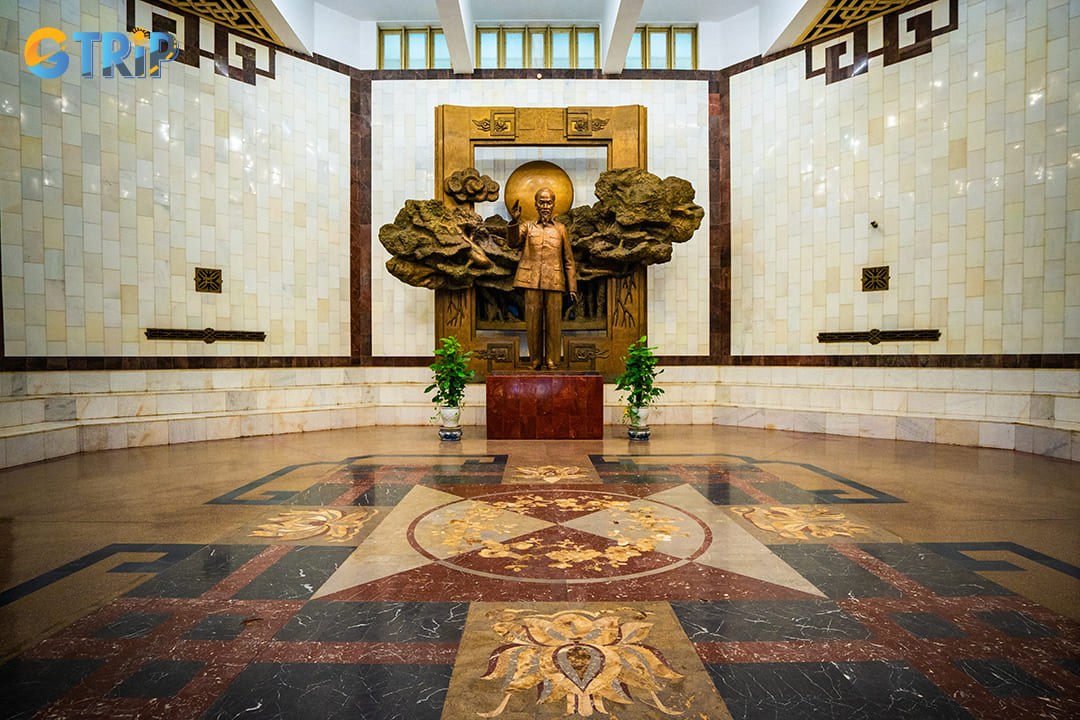
English-speaking guides are available within the Complex of President Ho Chi Minh
Are there any restrictions for children or elderly visitors?
Yes, while the complex is accessible to all tourists, certain restrictions apply, particularly at the Ho Chi Minh Mausoleum due to its solemn nature and security protocols.
Guidelines for children:
- Children under 3 years old are generally not allowed inside the Ho Chi Minh Mausoleum due to the quiet, formal atmosphere required.
- Older children must remain silent and respectful when entering the chamber.
- Strollers are not allowed inside the mausoleum, but they can be used in outdoor areas.
Guidelines for elderly tourists:
- The complex is wheelchair-accessible, though some areas, like the stilt house, have stairs.
- The mausoleum queue can be long; elderly tourists are advised to arrive early to avoid extended standing times.
- On hot days, it is recommended to bring water and a hat, as Ba Dinh Square offers little shade.
For those needing assistance, wheelchairs are available for rent at the entrance, and staff are generally accommodating toward elderly and disabled tourists.
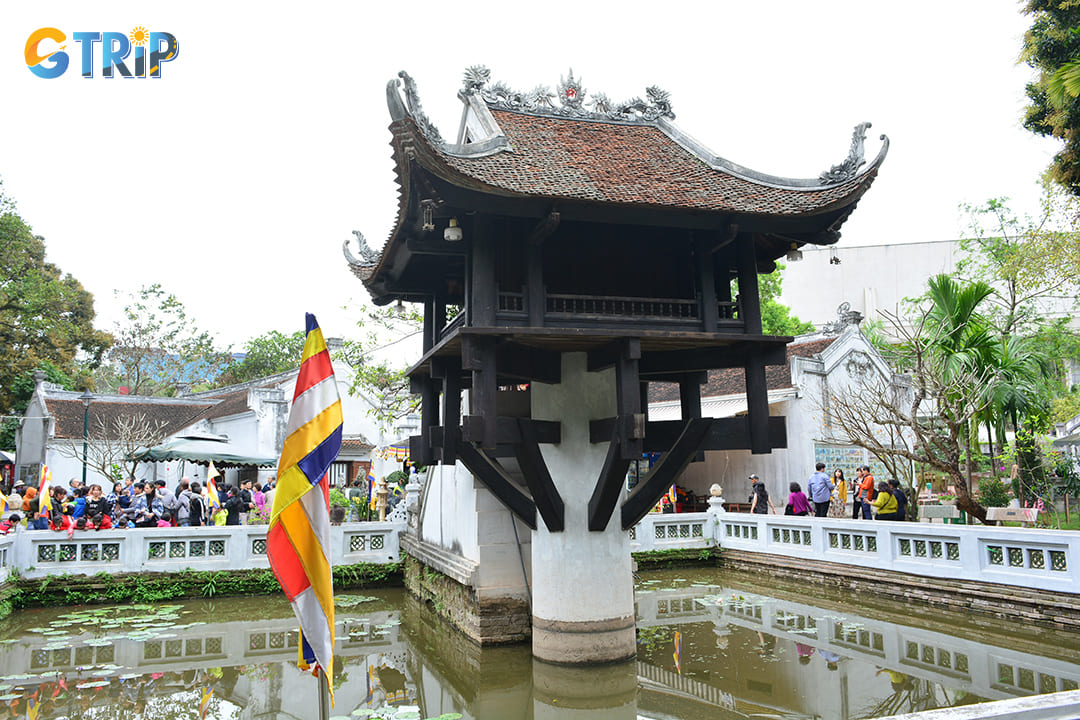
Certain restrictions apply, particularly at the Ho Chi Minh Mausoleum due to its solemn nature and security protocols
The Complex of President Ho Chi Minh stands as a profound testament to Vietnam’s revolutionary history and the enduring legacy of its beloved leader. Through this article, we've explored its historical significance, key landmarks, and the cultural value it holds for both Vietnamese people and international tourists. By understanding the deep symbolism behind locations like Ho Chi Minh’s Mausoleum, the Presidential Palace, and the Stilt House, you gain more than just historical knowledge. For those planning a visit, learning about the best times to go, what to expect, and how to navigate the site can significantly enhance your experience. If you're interested in discovering more about Vietnam’s historical sites, explore our related articles on GTrip - Vietnam Travel Agency website to continue your journey through the country’s rich past.

